
Benito Mussolini pitching
his Fascism to the crowds – 1934
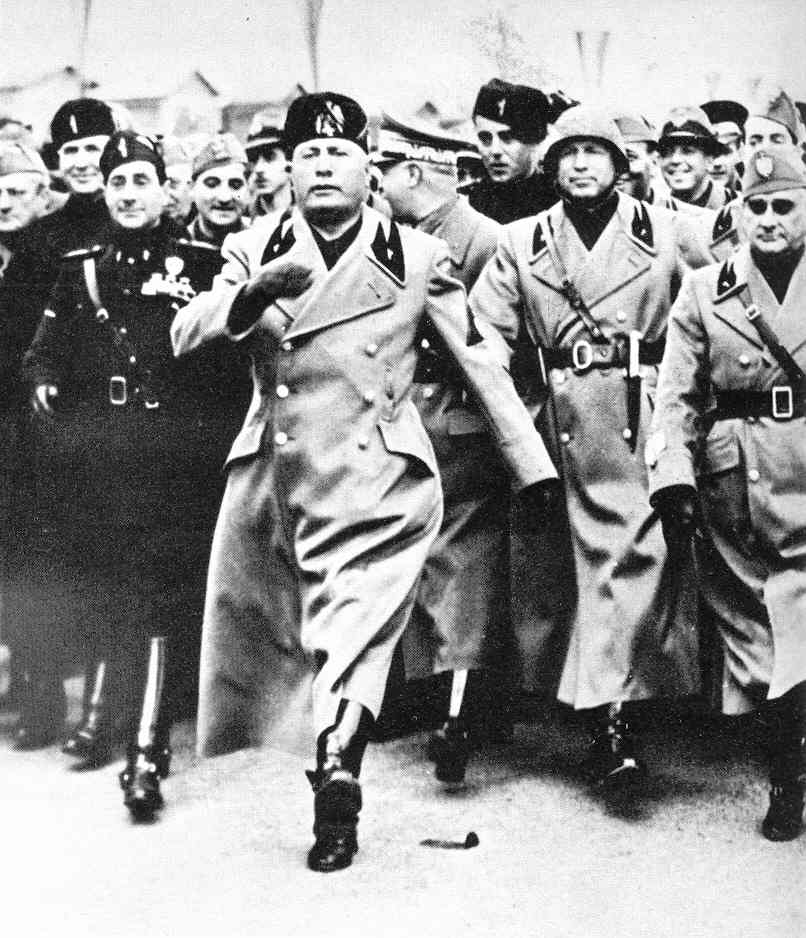
Mussolini aping the German
goose step as he leads fellow Fascists on a march – 1938
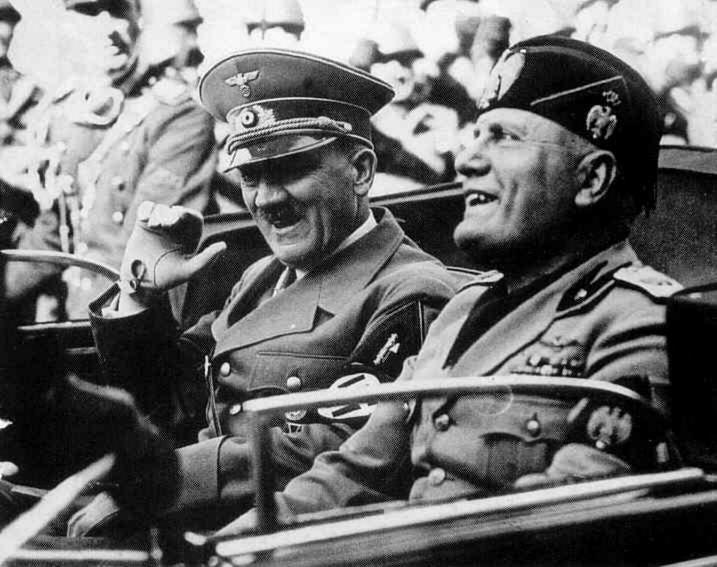
Hitler and Mussolini – 1938
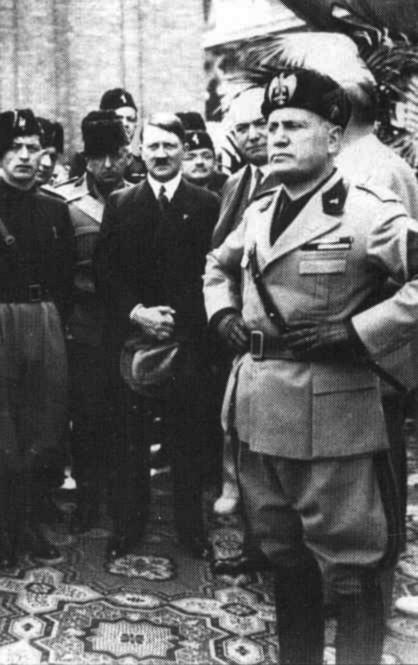
Hitler and Mussolini in
Rome
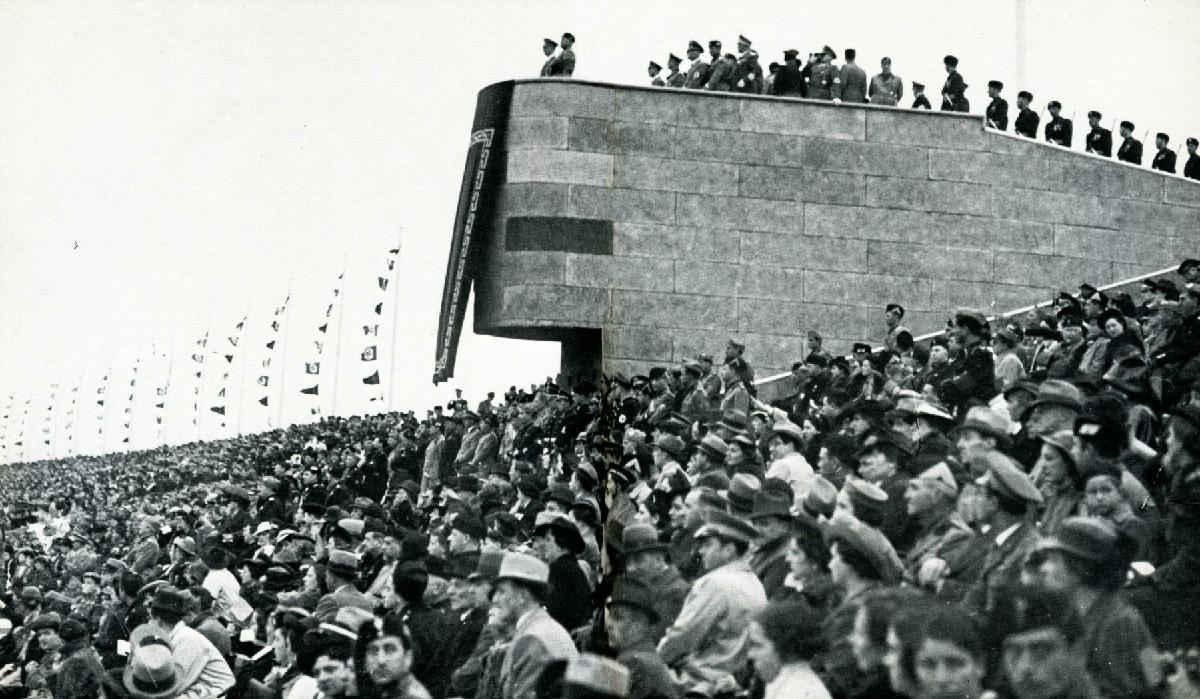
Hitler and Mussolini gaze
down upon a crowd at a Fascist rally in Rome – 1938
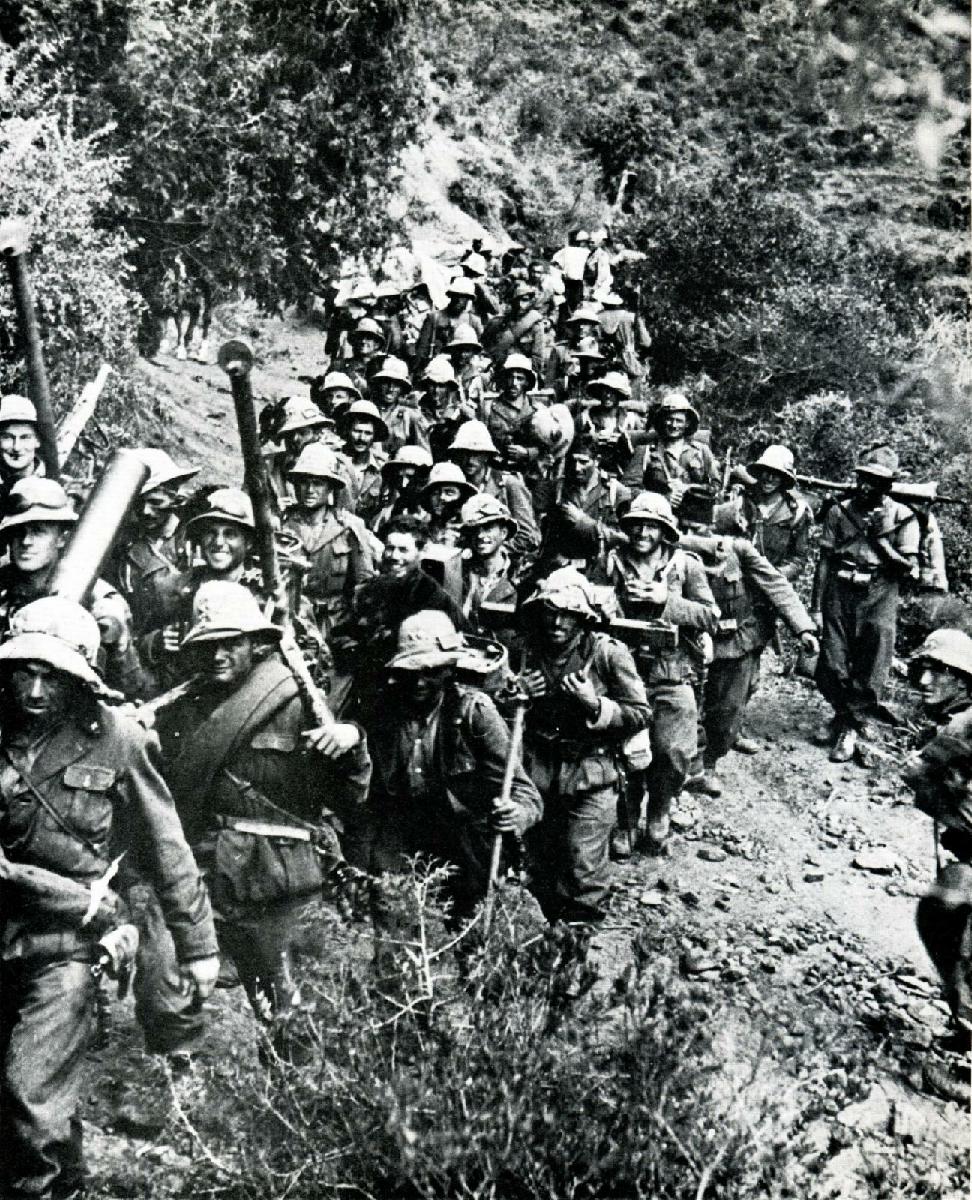
Italian infantrymen in Ethiopia – 1935
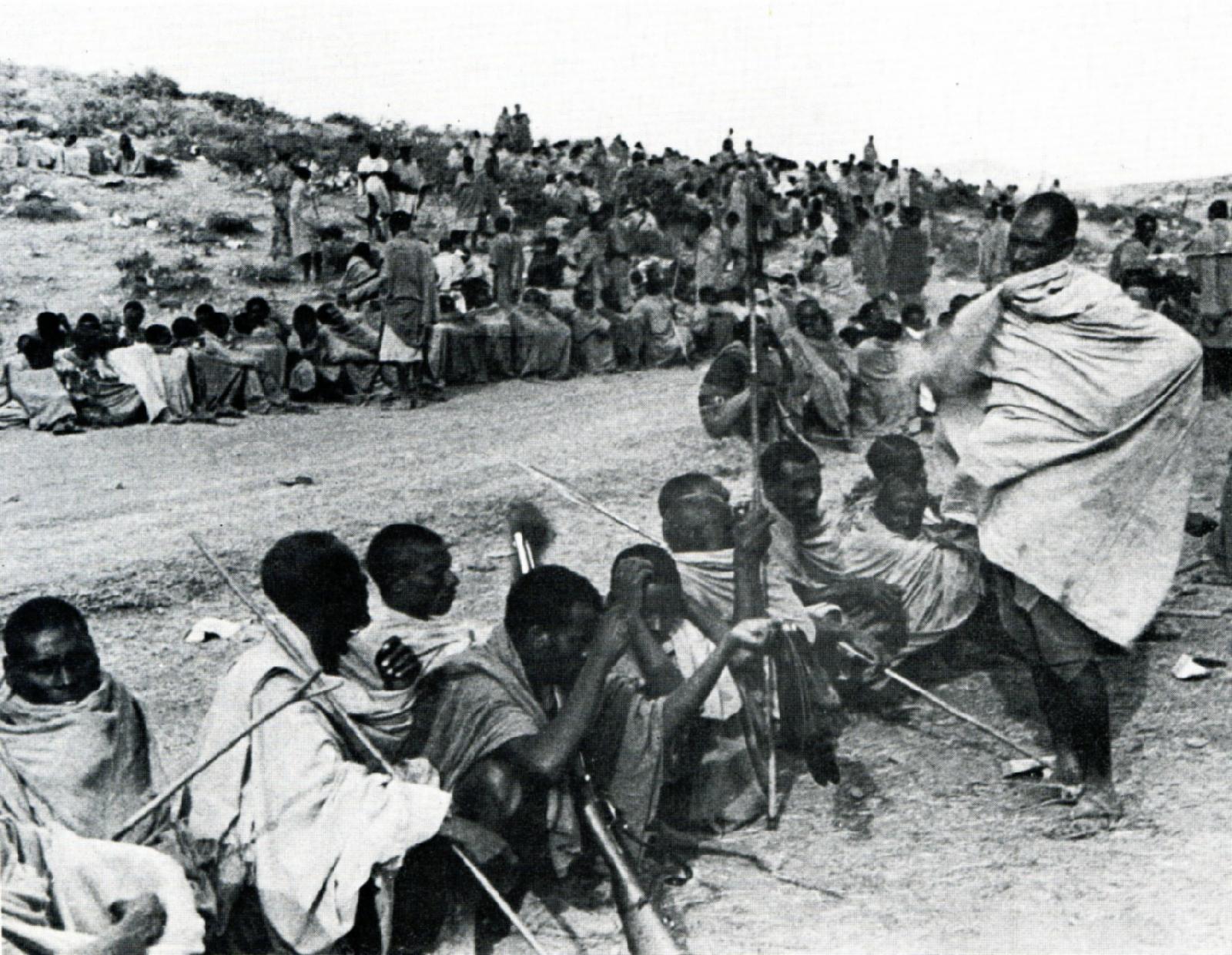
Ethiopian tribesmen – many
of whom defected to the Italians in the war
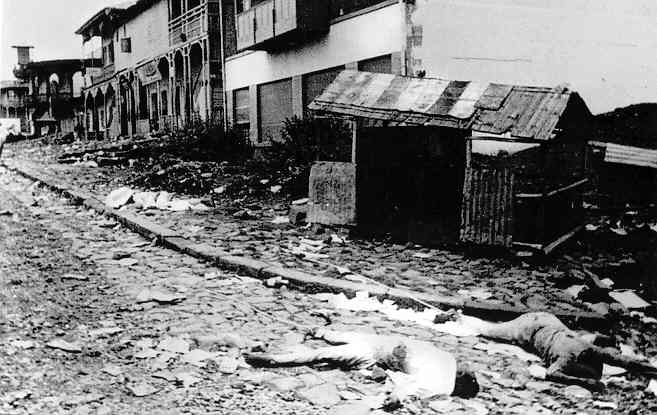
Ethiopians killed by Italian
bombing of their village
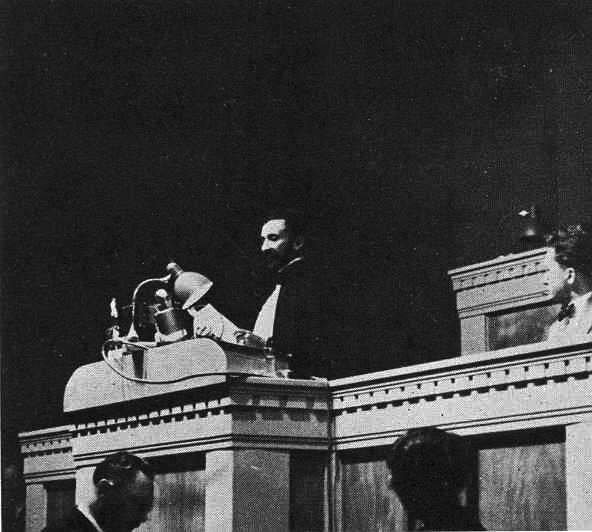
"It is us today, it will
be you tomorrow."


|
FRANCE AND
ENGLAND
SEEM TO HAVE LITTLE WILL TO STAND UP AGAINST THE RISING
DICTATORS
|

|
|
|
A divided France of the 1930s
In February of 1934 the growing antagonisms in
France between the political Left and the political Right – greatly
exacerbated by the Stavisky investment fraud which implicated many
Leftist cabinet members – erupted in the form of Paris riots, which
many thought was the prelude to an attempt at a Right-Wing political
coup. Order was restored to France. However, Left-Wing suspicions of
on-going Right-Wing Fascist plots, and similar suspicions by the Right
of Communist plots of the Left to take over France, split the country
into deeply hostile political groupings.
Besides the Left-Right deadlock over the
basic political path the country should take, the evolution of the
larger world of European politics, especially during the 1930s, made
French national politics even more complex. The French could not decide
which rising power to the East, Nazi Germany or Communist Russia, posed
the greater danger to Western, or at least French, civilization. Along
with this went wide disagreement on how to respond to Mussolini in
Ethiopia and the civil war raging in Spain (1936-1939).
In short – France really was not able to
get its act together at a time that it was supposed to be one of the
two major enforcers of the post war international status quo (the other
being Great Britain). Indeed, by the late 1930s France found itself
floundering in a deep domestic political war.
|
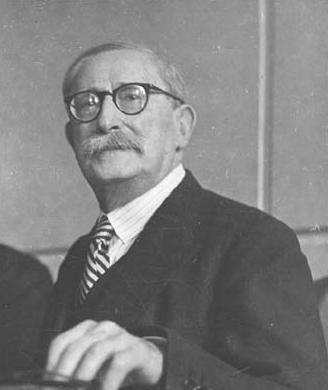
Léon Blum – French
Socialist Party leader and one of France's prime ministers
during the French leftist
"Popular Front" of 1936-1938
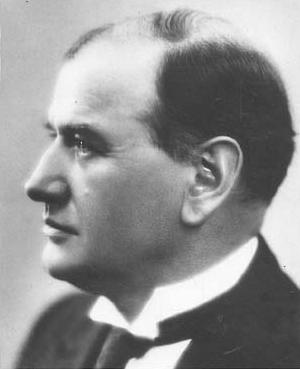
Édouard Daladier – head of the French "Radical" Party
and French Prime Minister
after the fall of the Popular Front in 1938 --
until just before Germany's
invasion of France in 1940
|
The British quest for peace – at any price
The Conservative Party leader Stanley Baldwin
dominated British politics during much of the period following the
Great War. Baldwin’s governance was characterized by a policy of
peace-at-any-price. He understood that the British did not want ever to
go to war again; that they expected him to keep them from diplomatic
entanglements and any military buildup, viewed at that time as largely
responsible for the Great War of 1914–1918; and that his first priority
as Britain’s leader was to get the country back on sound economic
footing.
Thus he cut back tremendously on British
military spending and strength at a time that Germany was rebuilding
its military power (happening even before Hitler took charge of Germany
in 1933) – in well-recognized violation of the terms of the Versailles
Treaty of 1919 and the Locarno Pact of 1925. Every effort was made by
Baldwin (and most British politicians and intellectuals) to excuse
Hitler's moves to remilitarize Germany – on the basis that Germany was
only compensating for the horrible injustices inflicted on Germany by
the now notorious Versailles Treaty.2
Thus Baldwin and fellow Conservative
Party member Winston Churchill (himself a former party leader) found
themselves constantly at odds over this issue of Great Britain's
pacifism in the face of German remilitarization. Baldwin viewed
Churchill as a war-monger who wanted to drag Great Britain into an arms
race and thus another war with Germany. Churchill viewed Baldwin as one
who invited German military adventurism by the obvious lack of English
resolve to stop Hitler before he became so strong that there would be
no way to block his military ambitions.
Basically, Baldwin was working out of the
spirit of the moment, of the times he lived in. Churchill was working
out of a longer sense of British history – and its long-standing role
as balancer of power on the European continent (as for instance in the
days of Napoleon in the early 1800s). History would soon be the judge
of which of the two had it right.
2The
spirit of total pacifism was so strong in Britain that not only did the
British Communist and Labour Parties on the Left denounce British
remilitarization but also in 1933 the Oxford Union debated the issue of
British intervention in the Japanese takeover of Manchuria, producing
(with a vote of 275 to 153) a final resolution declaring that "this
House will in no circumstances fight for its King and Country." The
resolution brought on much debate not only in Britain, but around the
world. Churchill was loud in his contempt for this resolution!
|
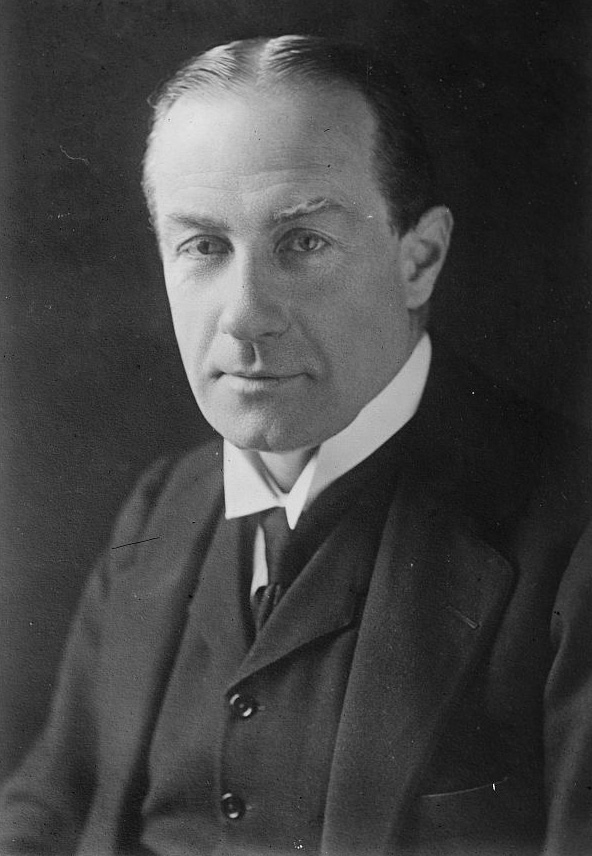
Stanley Baldwin (Conservative
Party) – British Prime Minister – 1923-24; 1924-29; 1935-37
|
Chamberlain's "appeasement" policy
Then in May of 1937 an exhausted Stanley Baldwin
stepped down and the new Conservative Party leader Neville Chamberlain
became English Prime Minister. Whereas Baldwin had been a pacifist,
Chamberlain was actually rather pro-German. As the 1930s developed, it
appeared that Great Britain too was facing a choice of which of the two
growing military powers to the East, Communist Russia or Nazi Germany,
was the greater threat to the peace of Europe (and thus also the
world). Chamberlain took the view that it was the Russian Communists
that posed the greater danger, and a policy of "appeasing" Germany's
Hitler (and Italy's Mussolini) would bring the nations of West and
Central Europe into a broad anti-Communist/anti-Russian front.
But Great Britain (and Europe) would soon discover the shortcomings of the appeasement approach to Hitler and his doings.
|
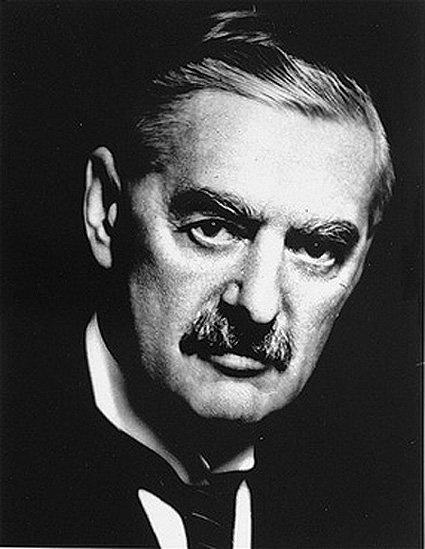
Neville Chamberlain (Conservative
Party) – British Prime Minister – 1937-1940
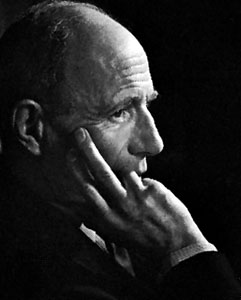
Edward
Frederick Lindley
Wood, 1st earl of Halifax – British Foreign Minister – 1938-1940
also an "appeaser" toward
Germany
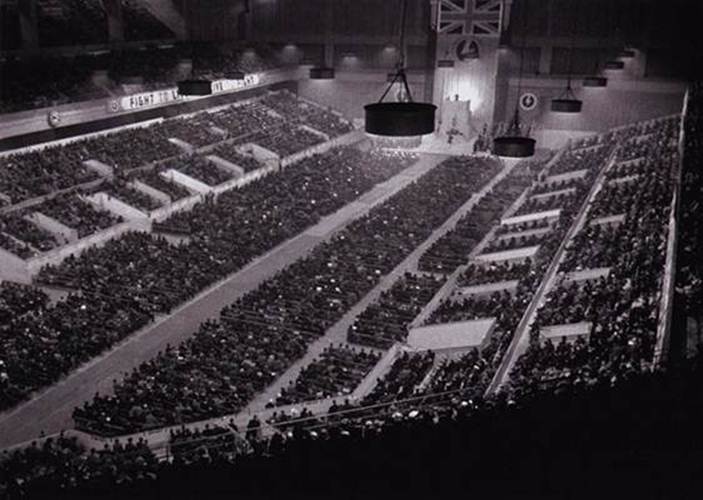
The British Union of
Fascists
and National Socialists Rally – London, 1936
One of the largest public meetings held in
Britain in the 1930s ... and indicative of the mixed
sentiment of the
British
about which way to turn in the face of continental
developments



|
THE SPANISH CIVIL
WAR
(1936-1939)
|

|
|
|
Although Spain was a Constitutional Monarchy (like
Great Britain and most of the rest of the European continent) the
country had actually been run by a system of local bosses (caciques)
with little interest in turning Spain into a modern society. Spain
itself was highly divided as to the direction it wanted to go,
especially after the Great War, which Spain stayed out of but which
benefitted a small group of industrial entrepreneurs who sold goods to
the combatants. The vast and highly traditional countryside (strongly
Roman Catholic and even semi-feudal in mentality) was greatly alienated
by this small intrusion of modernity into a society still romantically
attached to the glorious past of the 1500s, a past that was very
unlikely to ever return. Then there were the new industrial workers who
grudgingly took their place in Spain's factories, who felt a bit of
kinship with the Russian workers who similarly had moved abruptly from
feudalism to modern industrial society – led by Communist idealists
(the Bolsheviks). In short, Spain was a confused and highly divided
society.
Into that confusion stepped Spanish
General Primo de Rivera – who seized power in 1923, and forced economic
and social discipline on Spain, settling things down a bit (and
eliminating the caciques) – but whose rule gradually began to draw
strong criticism from impatient modernizers who felt that his
Mussolini-like grip over Spanish society (and the Spanish monarchy that
supported him) was only serving to block real social progress.
Ultimately both Rivera and King Alfonso, tiring of the situation, in
1931 called for a referendum on Spain's future. The results went in
favor of a Republican government, and Rivera stepped down and the king
abdicated.
But the Republican government's move to
secularize Spain's Catholic culture (undercutting the Church's role in
the country's schooling and cultural disciplines, such as its stand on
marriage and divorce) served only to deepen the cultural division that
split Spain into two hostile groups, the Republicans concentrated
heavily in urban Spain – actually bitter about the slowness of the
social reforms (and increasingly of a Communist or anarchist frame of
mind) – and the more rural Nationalists who clung desperately to a
clearly dying traditional Catholic Spain.
Back and forth power swung in the
national parliament (the Cortes) until by mid-1936 the battle had moved
to the streets in the form of fighting between the two groups: the
Conservative Falangists (backed by a very conservative Spanish
military) and the proto-Communist Republicans (supported by 200,000
Asaltos or fighters). This was the signal for General Francisco Franco
Bahamonde to leave his position in Morocco with accompanying
Nationalist troops and head to Spain, to fight the Republicans. At this
point the very bloody Spanish Civil War broke out.
But this civil war did not actually
remain much of a civil war. Instead it turned itself quickly into a
test run of the superpowers, especially Germany and Italy which
intervened on Franco's side, to try out their new military products and
strategies (dive bombers, for instance). At the same time, Stalin sent
a huge number of advisors to help the Republicans against Franco – as
did also France and Britain, although only on a very small scale.
Volunteers poured in from America serving on one side or another,
Hemingway, for instance, actually serving with the Republicans –
building his 1940 novel, For Whom the Bell Tolls, on his own experience in the war.
Feelings ran very hot on both sides of
the war, both sides destroying villages (and killing villagers) caught
in the crossfire. And major atrocities occurred: Leftist Republicans
killing priests and raping nuns – and the Nazi allies of Franco
leveling the town of Guernica as practice in developing divebombing
techniques that would later be used by Hitler in his conduct of
Blitzkrieg (Lightning War).
Little by little Franco's Falangists
(with a lot of help from the Germans and Italians) were able to gain
ground against the Republicans, until in 1939 Madrid was finally taken
by Franco, and the war came to a halt.
Spain was devastated. And it
would have presiding over it a dictator determined to shape Spain
exactly as he himself determined, all the way up until his death
decades later (1975).
Also, Spain was exhausted, and
in no hurry to get involved in another war (they would also sit out
World War Two).
But everything that pointed to the tragedy that
was about to break out in Europe was contained in those events of
1936–1939. The Spanish Civil War, in fact, was simply a dry run
on the larger war that Hitler had planned for Europe. And the
responses of all the major players to the events focused on Spain would
resemble very closely how the diplomacy and military development would
occur as events leading up to World War Two. But few understood
this at the time, especially the British and French who continued to
hope that they somehow knew the formulas for keeping the peace in
Europe. Spain taught them nothing.
|
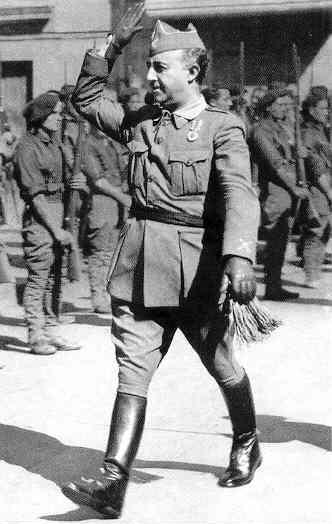
Francisco
Franco – leader of the Falangists or Nationalists
... who also absorbed the traditionalist Carlists into his organization
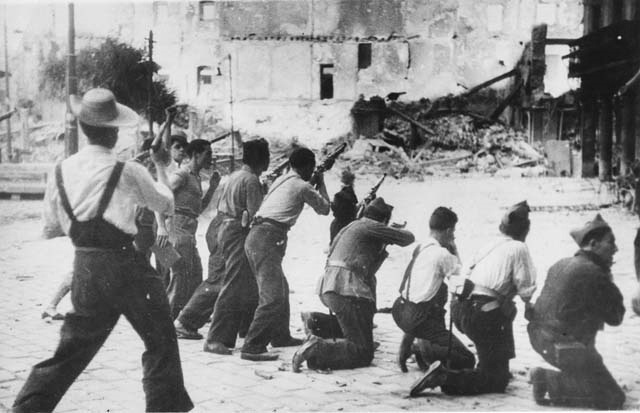
Republican militia
closing in on Nationalists barricaded in the ruins of the Alcazar in
Toledo
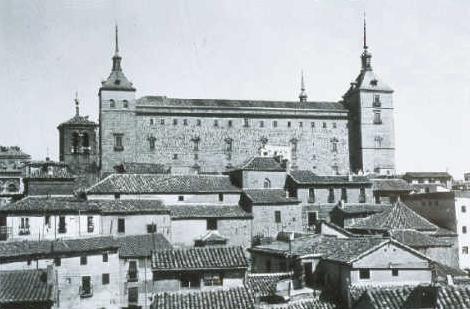
The famous Alcazar in Toledo,
where the Nationalists held out for days
against the Republicans,
was razed to the ground – August 1936.
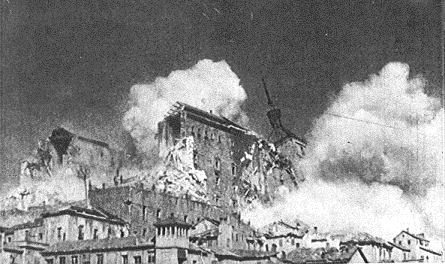
On
September 27, Franco's Nationalist forces reached Toledo and drove the
Republicans off – thus ending the siege – and making Franco the hero
of the Nationalist cause. Two days later Franco proclaimed
himself Generalissimo and shortly thereafter took the title as Head of State.
When Seville fell to the Nationalist troops, 200,000 workers (heavily
Communist) were stirred to counter-action in Madrid by the passionate
Dolores Irarruri ("la Pasionaria"). This was a call to arms of
those loyal to the Leftist Republic.
|
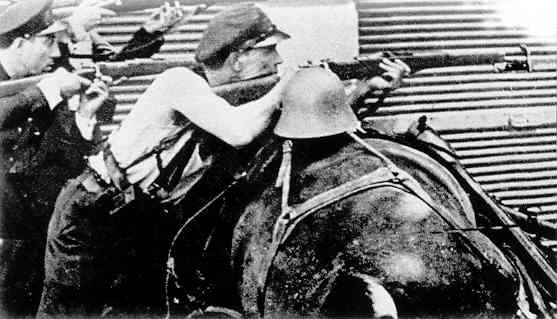
Communist militiamen during
the early stages of the Civil War
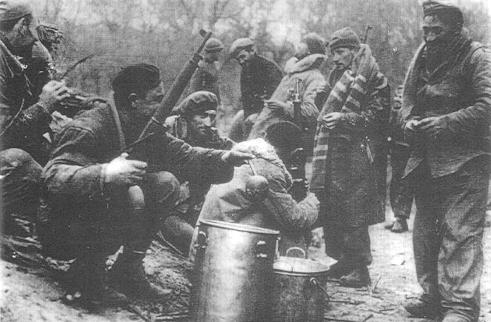
Republican International
Brigade troops at Casa de Campo on the western outskirts of Madrid
during the battle against
Franco's invading Nationalist forces – November 1936
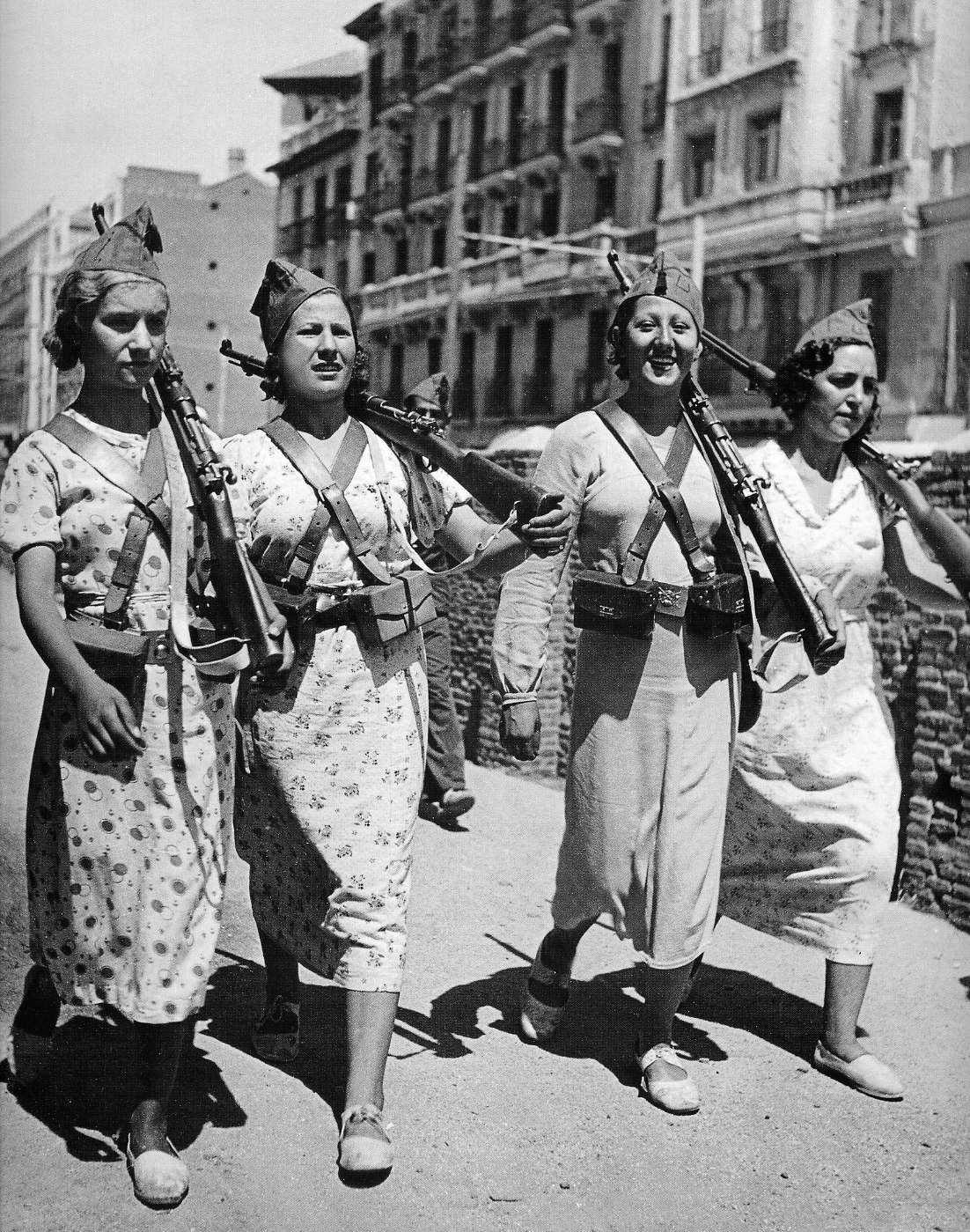
Spanish loyalist (Republicanist)
women militia
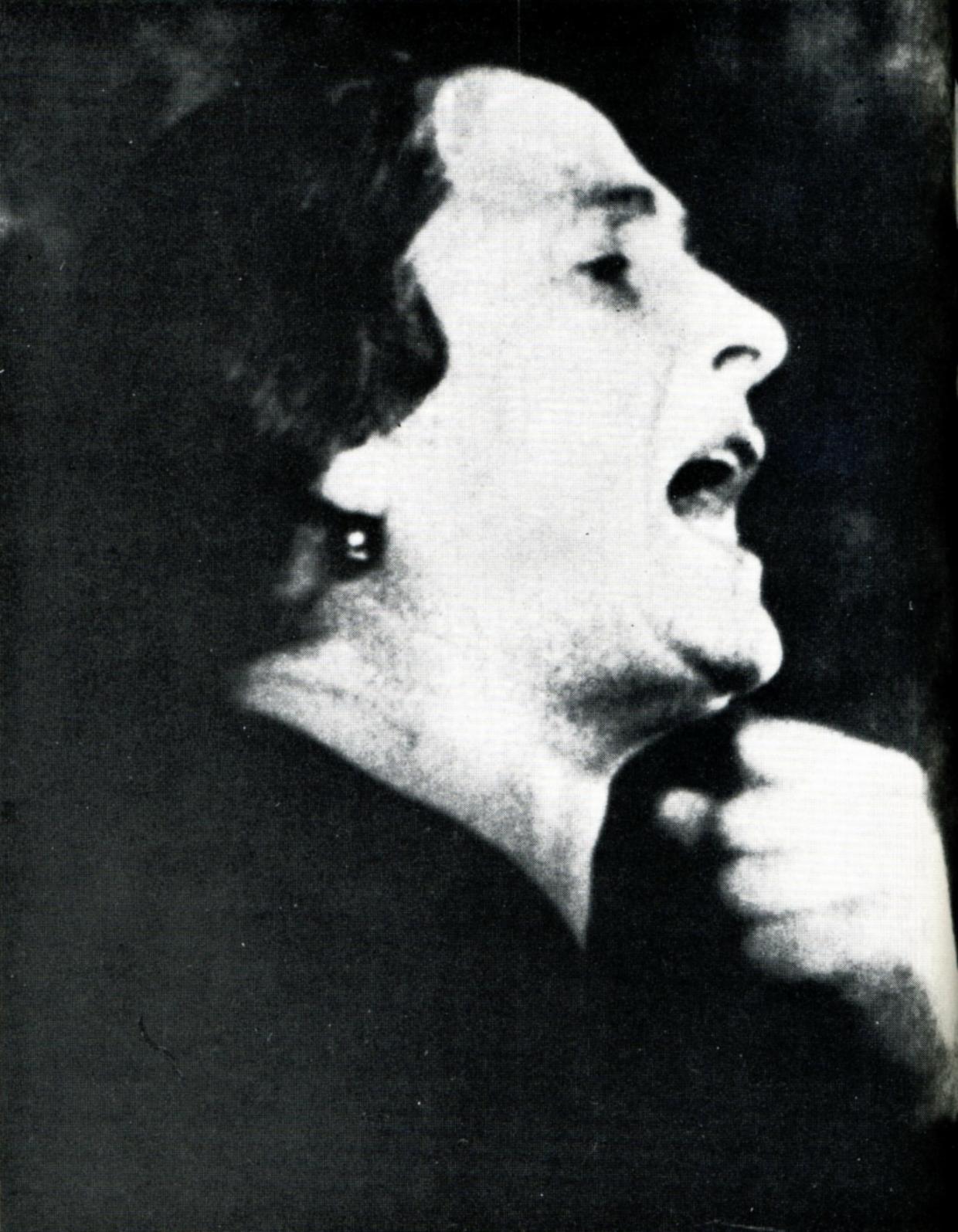
Dolores Ibarruri - "la Passionaria" stirs Communists to action
in support of the Republican cause
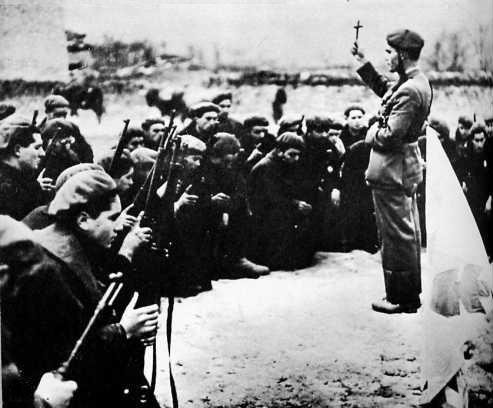
Carlist requetés receive
the benediction before an assault on Irun – 1936
|
International Involvement
Seeing a fellow Popular Front Government in Spain under threat by
Rightist forces, Leon Blum's Leftist Popular Front government in France
quickly sent 30 French planes and pilots to help the Republican
government crush the rebels. But in turn, Franco called upon the
Nazis of Germany and the Fascists of Italy to come to the aid of the
Nationalists' cause. By the end of July German and Italian
planes were arriving in Morocco to assist Franco in his revolt against
the Republican government of Spain. Thus the Spanish civil war became
from the very outset an international issue.
However, the Spanish Civil War became an international issue not just because
foreign countries wanted to help out one side or the other in the
struggle – but because the war in Spain gave a number of countries the
opportunity to develop and test larger political, military and
diplomatic strategies of their own.
Battle of Guadalajara (8 March – 23 March 1937)
Mussolini's
Italians and Franco's Nationalists combined forces to
attack Madrid from Guadalajara. Vastly outnumbering the
Republican forces, the Italians and Nationalists were at first
successful in taking one small town after another. But bad
weather – and the arrival of the International Brigade stiffened the
Republican defense (though they were still outnumbered 2 to 1).
The Republican air force was also operating from concrete runways –
whereas their opponents were grounded with an airstrip of mud.
Gradually the Republicans began to push the Italians and Nationalists
into full retreat. The Italians lost some 6,000 men in the action
– and Mussolini lost a huge amount of prestige, for he had personally
organized the Italian effort in order to gain the prestige of what he
originally thought was going to be a grand victory.
|
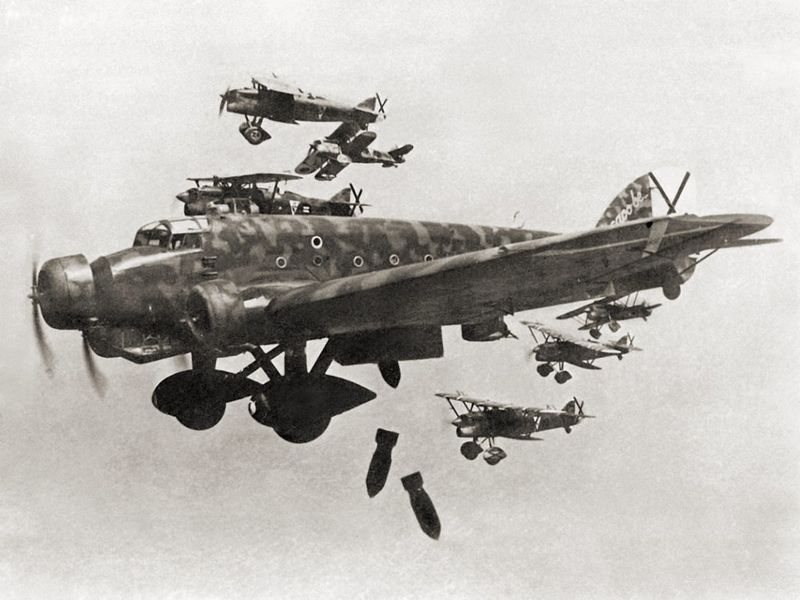
A Savoia-Marchetti SM.81
during a bombing raid in the Spanish Civil War
|
The bombing of Guernica, April 26, 1937
The bombing of Guernica was an aerial attack by the German Luftwaffe
squadron known as the Condor Legion against the Basque city of Gernika
(Spanish: Guernica).
|
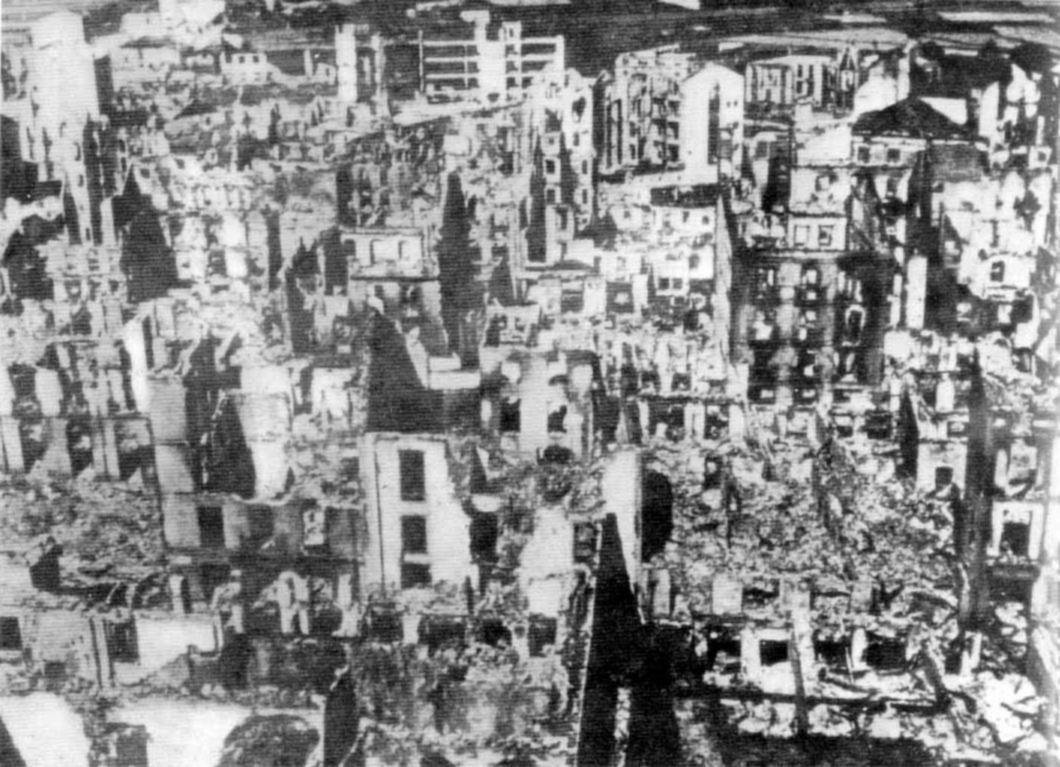
Guernica, after the bombing
of April 26, 1937
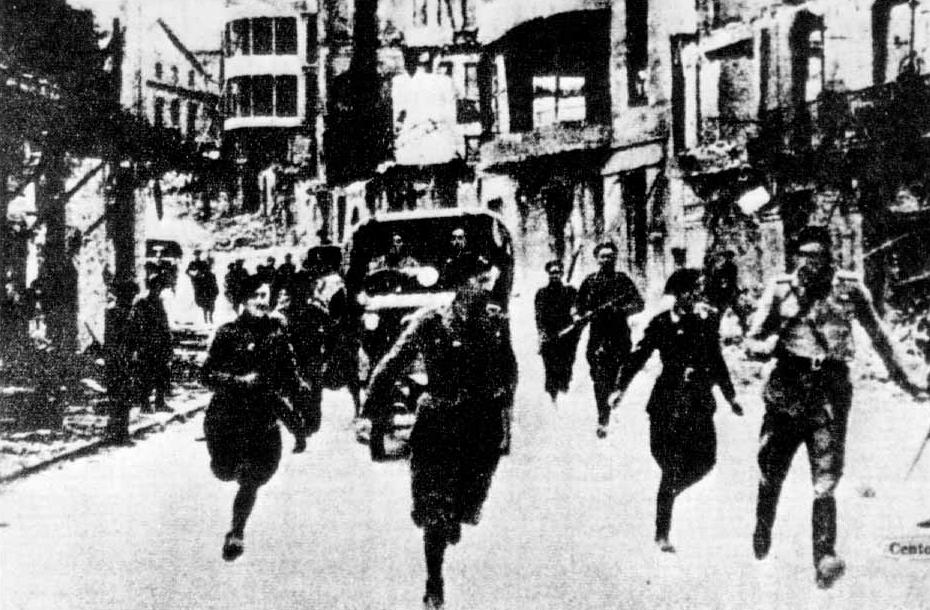
Italian troops entering Guernica
after the bombing
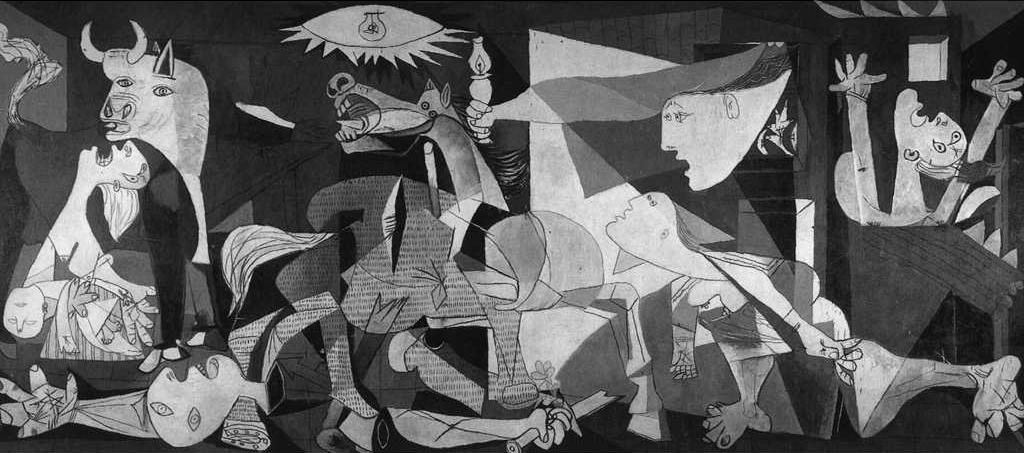
Pablo Picasso – Guernica – 1937
The huge mural was produced
under a commission by the Spanish Republican government to
decorate the Spanish Pavilion at
the Paris International Exposition (the 1937 World's Fair in
Paris)
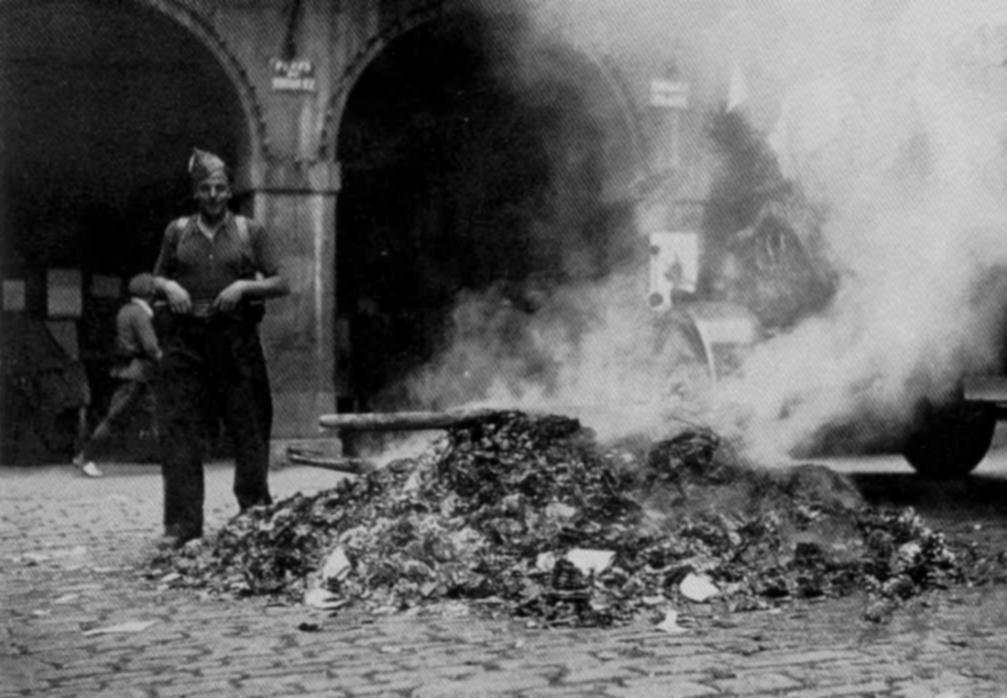
Francoists burning Basque
secular school textbooks in Guernica
The Catholic Church offers its full support to Franco
in his overthrow of the democratically elected
Spanish Republican government
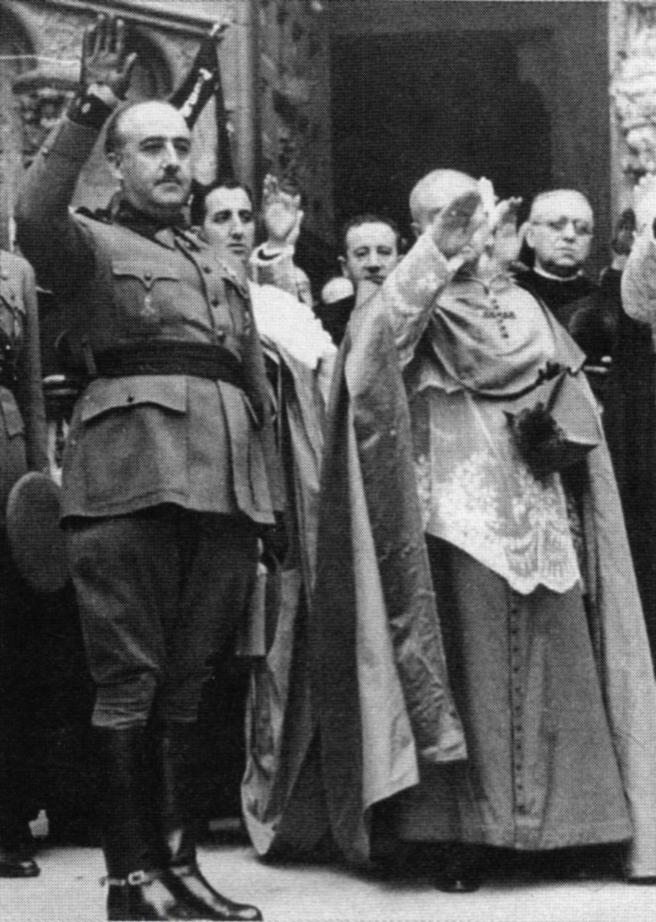
The Spanish Catholic Church
demonstrating its support of the Falangist (Fascist)
General Francisco Franco – November 1938
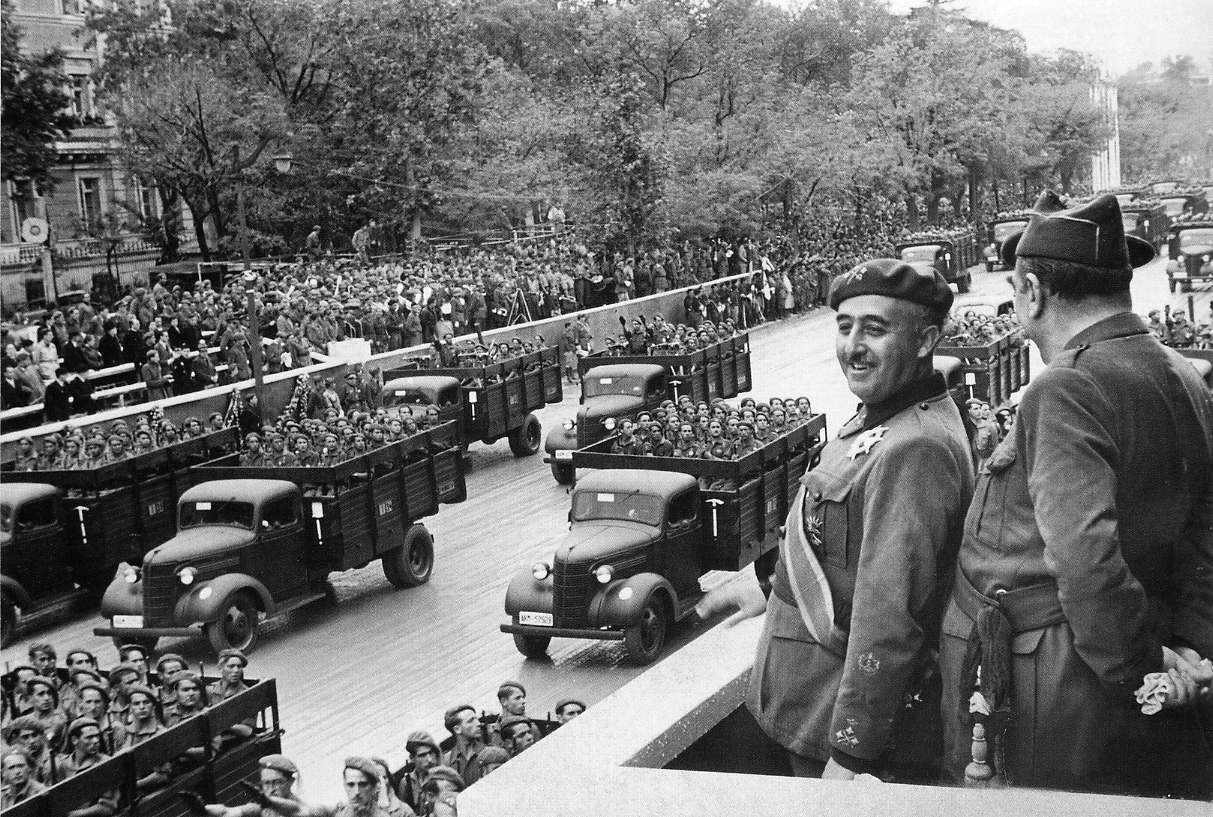
Generalissimo Francisco Franco
reviewing his Falangist troops after taking Madrid in 1939


|
JAPANESE
IMPERIALISM
IN ASIA
|

|
|
|
Japan had come to consider itself one of the great
world powers as the 20th century got underway, having modernized its
army and navy to the point that it was able to defeat Tsarist Russia in
a Siberian war fought in 1904 and 1905. Also, although the Great War
(1914–1918) was essentially a European war, Japan played a part as an
Asian ally of the British and French – and was rewarded accordingly by
the formal recognition on the part of those victorious powers of the
Japanese takeover of German colonies in the Pacific.
America, of course, was wary of Japanese
broader interests in Asia (the Philippines was an American protectorate
defended by a number of American troops posted there). But in general
Japanese-American relations remained somewhat friendly, although the
Japanese were insulted by America's 1924 Immigration Act, which reduced
greatly the number of immigrants allowed to come to America – virtually
excluding all Japanese.
But the Japanese were making an effort to
move closer to the ideal of democracy – democracy supposedly having
proved itself the stronger social system in the recent war with
autocracy.
However with the onset of the depression,
democracy was not looking so impressive, and the Japanese military
group within the Japanese Imperial Cabinet began to take a scornful
attitude toward the Japanese pro-democracy civilian politicians – who
had agreed to internationally determined formulas of naval and military
disarmament – the military party pressing instead for a military
buildup of both the army and the navy. Indeed, radicals within the
Japanese military were calling for a revival of Shinto, a somewhat
mystical philosophy stressing the virtue of military valor or bushido –
even the glory of death in battle. For some (especially the younger)
Japanese soldiers, Shinto and its bushido ethic formed for them an
intoxicating ideal.
By the early 1930s civilian leaders were being assassinated – and cabinets were being turned over with destabilizing rapidity.
Also in 1932 young officers in the
Japanese occupation army in Manchuria (northeastern China) staged a
fake crisis and used the event to simply take full control of the
Chinese province and set up a puppet government there. The Japanese
Emperor Hirohito did not seem to object – and the civilian government
seemed unable to undo the takeover (very popular with the Japanese
people).
|
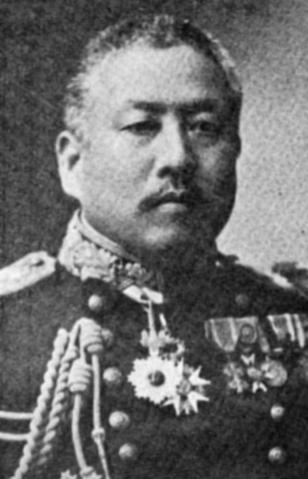
Japanese Prime Minister Makoto
Saito – 1932-1934
The Imperial Pictorial,
vol.2
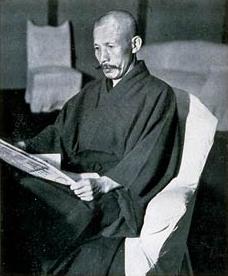
Japanese War Minister Sadao
Araki
The chief theoretician for
the Kodoha ultra-nationalist Japanese
Time 1933
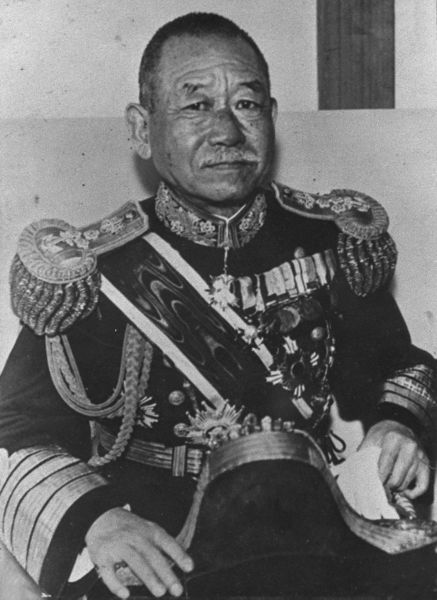
Japanese Prime Minister Okada
Keisuke – 1934-1936
National Diet Library archives,
Tokyo
|
World War Two begins in China (1937).
Tensions began to mount in the Chinese North
between the Japanese Imperial government and the Chinese Republican
government under President Chiang Kai-shek, tensions which exploded
into full battle between the two countries in July of 1937 over a minor
incident at a bridge along the northern border. Using this incident as
an excuse, the Japanese invaded with full force into China – by the
army from the north and by the navy along the east coast. In short
order, the Japanese overran the major cities of the Chinese coast,
bombing the civilian population in Shanghai and worse, raping and
pillaging the Chinese in their capital city of Nanking (Nanjing). But
the Chinese government simply retreated into the huge Chinese interior
– from there to conduct an ongoing resistance movement against their
Japanese occupiers.
Thus, World War Two in the East Asian
theater had actually begun, as the first chapter in this very barbaric
story. Yet America, though deeply shocked by the stories of the
Japanese atrocities committed against the Chinese, chose to look away
rather than get involved.
But developments in Europe, plus an
alliance between the Japanese and Hitler's Germany and Mussolini's
Italy, would eventually change that American stance – dramatically.
|
The "Luo Kuo Chiao Incident"
of July 7, 1937
When the KMT army refused to allow
Japanese troops to cross the bridge in search of a missing
soldier, shooting broke out between the Japanese
and Chinese – as the first blow of the war
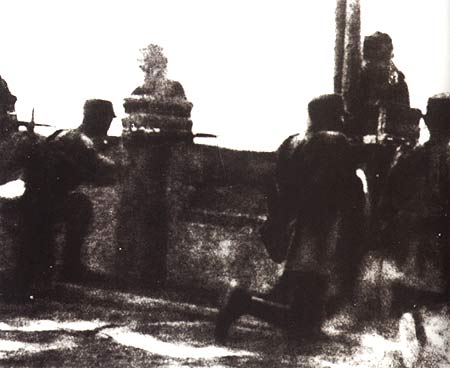
Chinese troops defending
the Luguo Bridge
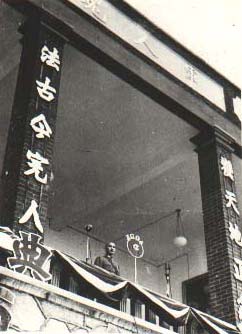
Chiang Kai-shek (Jiang Jieshi)
announcing the KMT's policy of
resistance against Japan
at Lushan on July 10, 1937,
three days after the Battle
of Lugou Bridge.
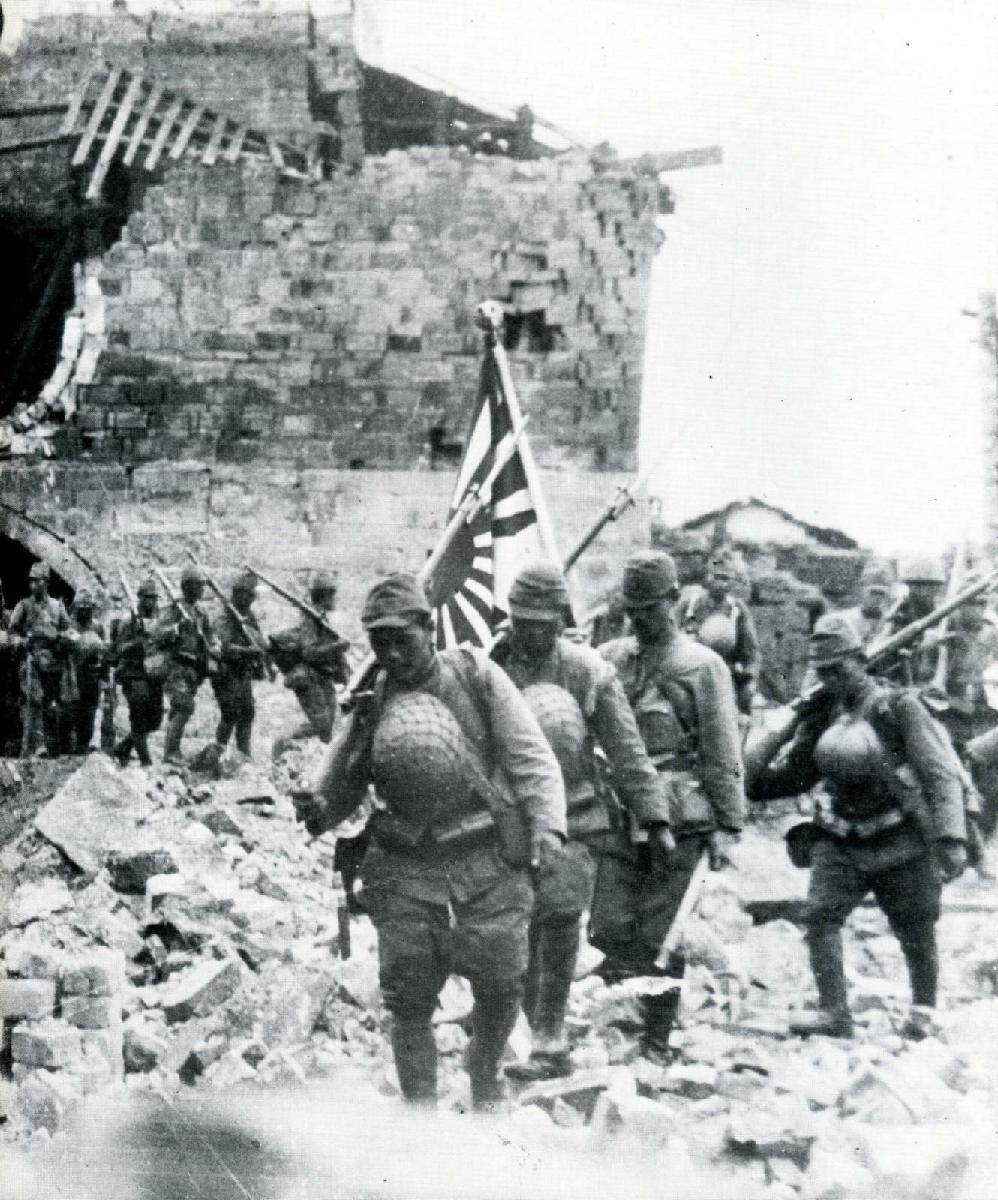
Japanese troops marching
through the rubble of a village near Hankow
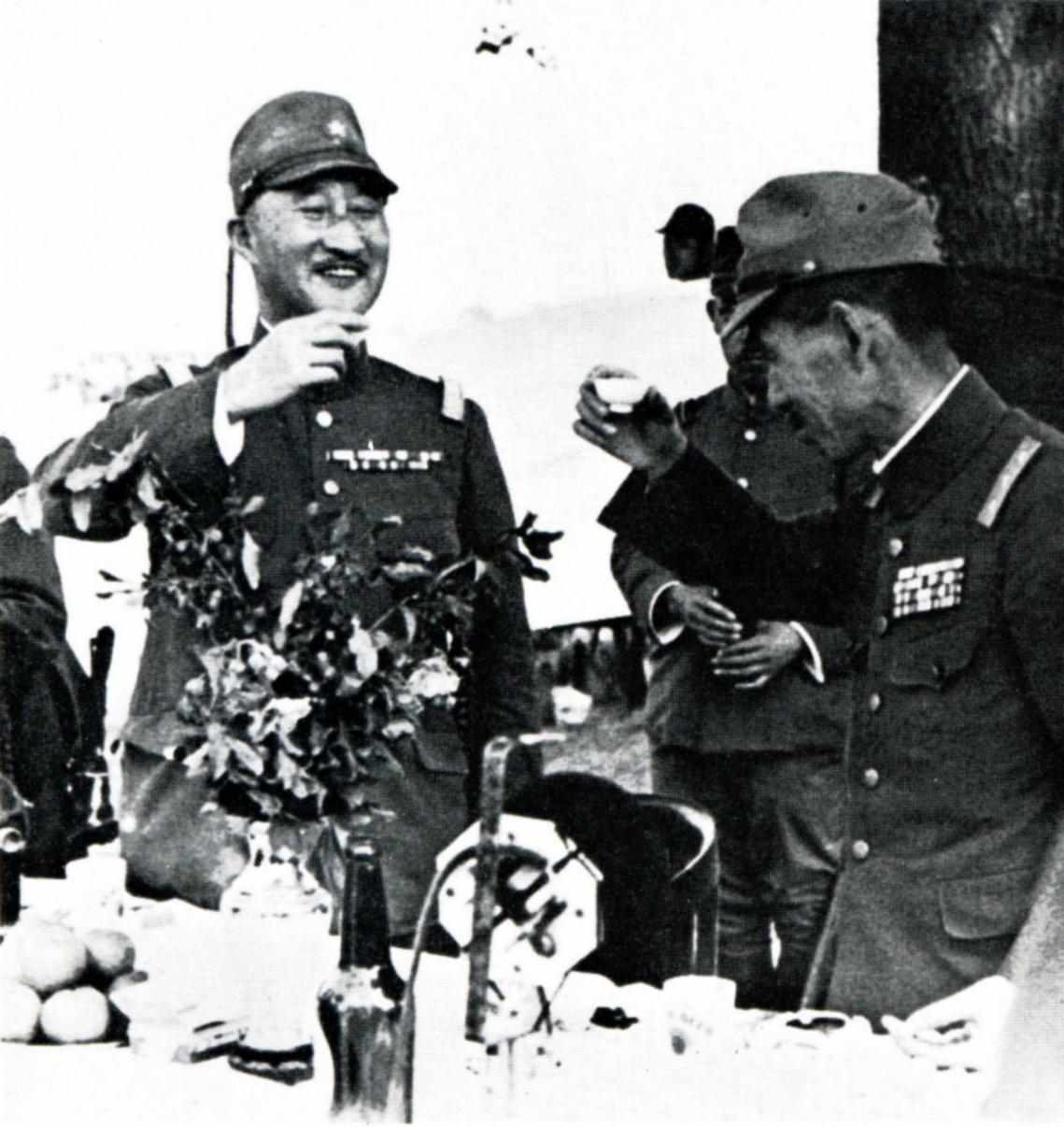
Japanese generals toasting
their victory at Hsuchow (Xuzhou)
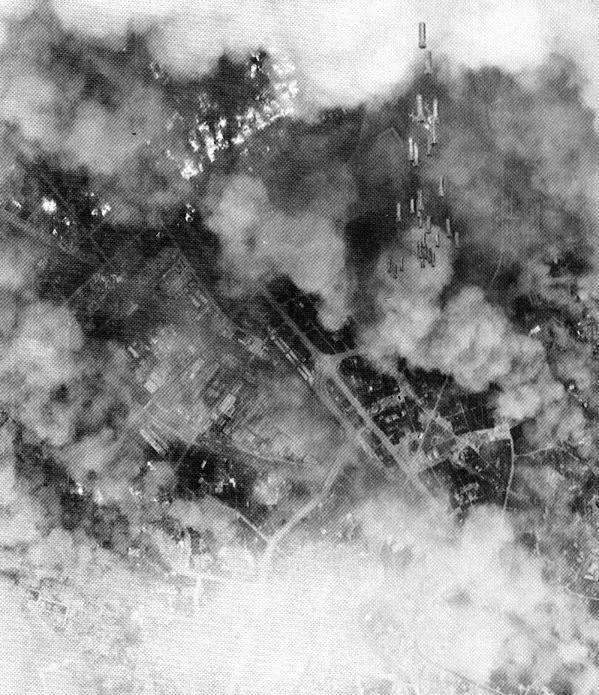
Shanghai – bombed by
Japanese
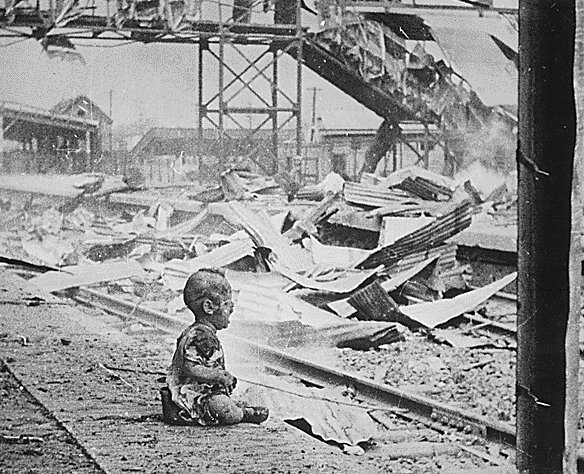
One of the last humans left
alive after intense bombing during the Japanese
attack on Shanghai's South
Station. August 1937.
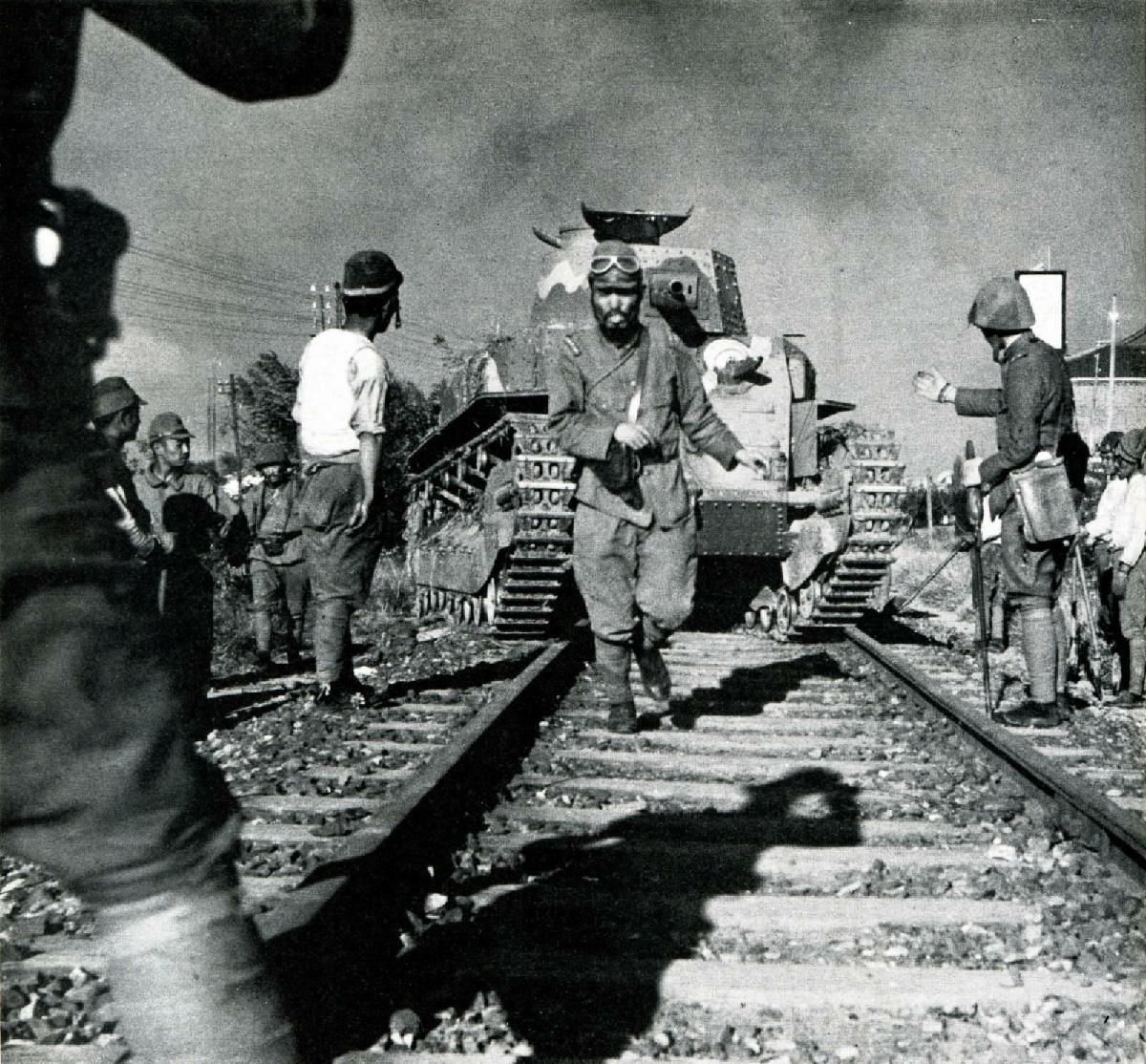
A Japanese tank rolls onto
the Shanghai-Nanking railroad
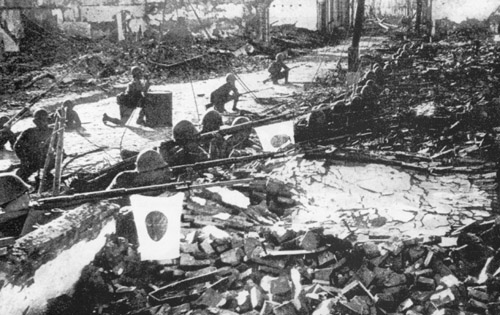
Japanese troops in the ruins
of Shanghai – 1937
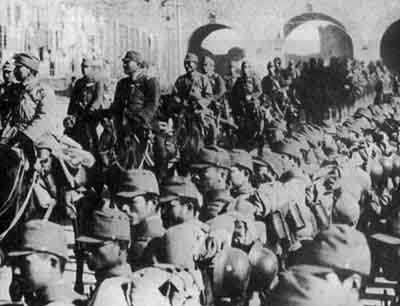
Nanking 1937: The ceremonial
entrance of the Japanese forces into the city of Nanking
(Nanjing) after the city
fell to the Japanese on December 13, 1937.
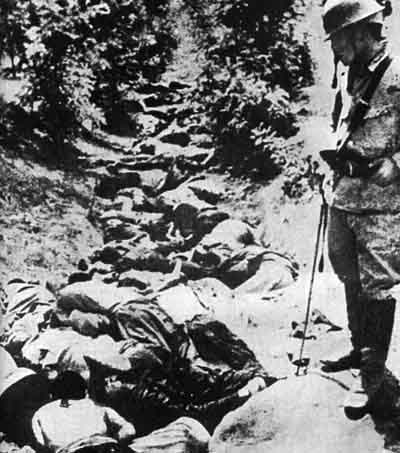
Nanking 1937
“Ten Thousand
Corpse Ditch”, where bodies of mass execution victims were
dumped.
(as many as 300,000 unarmed
civilians may have been executed over a 6-week period,
though the numbers are hotly
debated between the Japanese and Chinese even today)
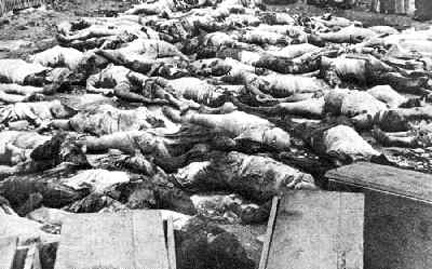
Nanking 1937: rape
and massacre of civilians
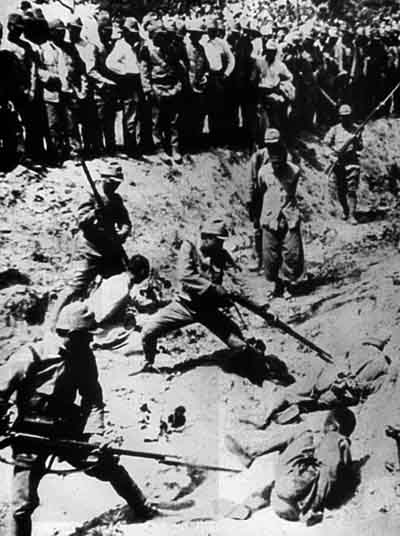
Nanking 1937: A photo
first published by Look magazine in 1938.
It shows Japanese army recruits
at a bayonet drill, practicing on Chinese prisoners.
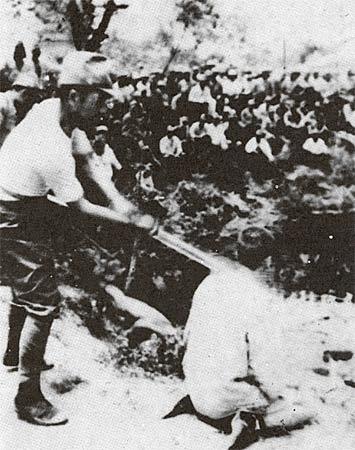
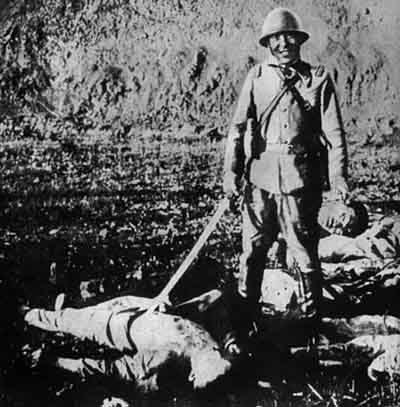
Nanking 1937: Japanese soldier
and beheaded Chinaman
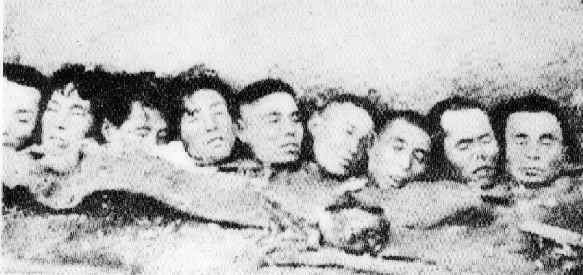
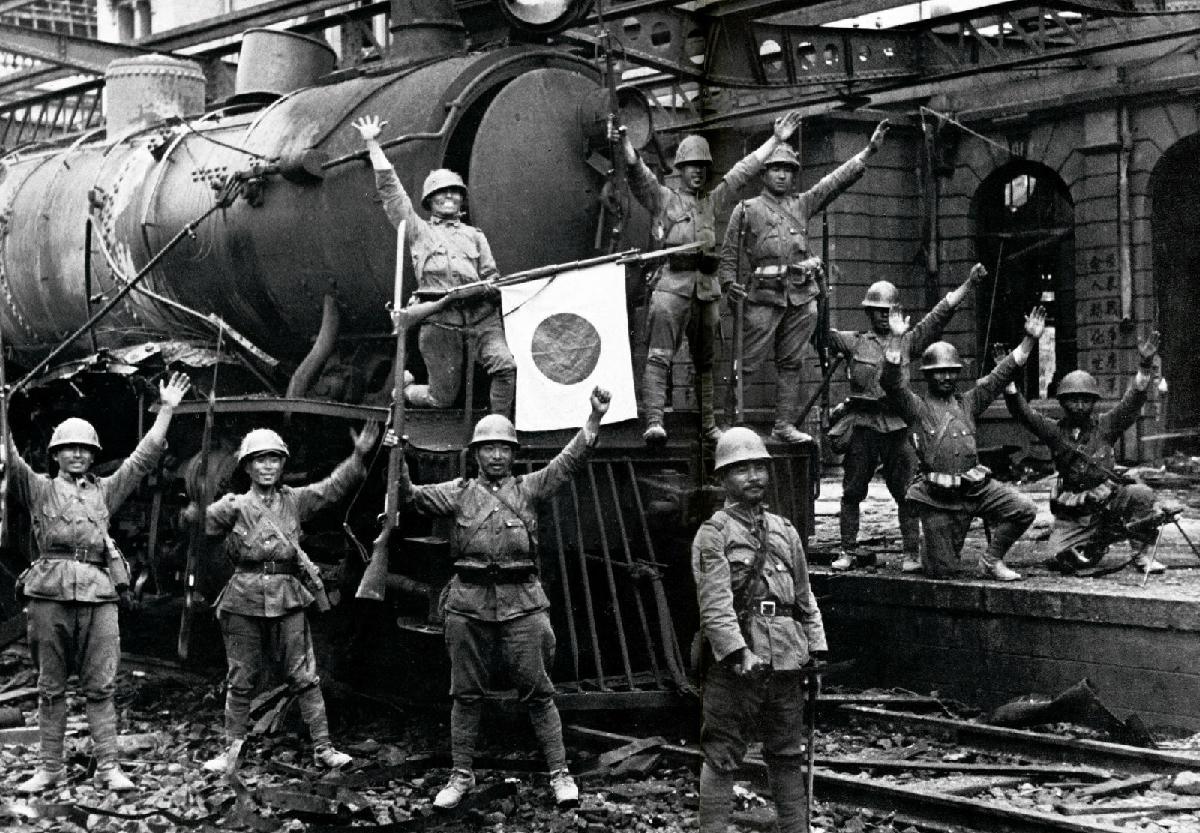
Japanese soldiers celebrating
the capture of Hankow
(temporary Chinese capital after the fall of
Nanking)


|
THE EXPANSION OF HITLER'S NAZI EMPIRE
GOES UNCHALLENGED
|

|
|
|
The logic of Chamberlain's appeasement policy soon
developed a life of its own, especially as Churchill continued to
challenge Chamberlain concerning the grave Nazi danger. Churchill, once
an avid anti-Communist, was taking the view (in the press and on the
radio as well as in Parliamentary debates) that with Hitler's rise to
power in Germany, the Nazi's were quickly becoming the greater threat
to Great Britain's security than even Stalin's Communist Russia.
Promises that each of Chamberlain's many
concessions to Germany would be the last were constantly broken by
Hitler – with each retreat by Chamberlain rationalized as necessary
steps in pacifying Hitler. Actually, each retreat only made the
dictator hungrier for German expansion. Sadly, Chamberlain (like
Baldwin) talked himself into believing that what he was doing – using
diplomatic Reason rather than brute Power – was protecting (rather than
undermining) the peace of Europe.
The German Anschluss with Austria (March 1938)
One
of Hitler's major political goals was
uniting German-speaking Austria with his German Nazi Reich (a move that
was forbidden by the treaties of 1919). He brought both his
cabinet and
his military in line with his policy (replacing leaders in both) and
then pressured the Austrian government to install more Nazis in their
cabinet. Meanwhile he began pushing Chamberlain's government to
allow
the unification of Germany and Austria, in theory as part of a stronger
defense against Communist expansion in East Europe. When
Chamberlain
seemed to be yielding, British Foreign Minister Anthony Eden
resigned. But Austrian Prime Minister Kurt von Schuschnigg
refused to yield,
finally arranging to have the Austrians determine the matter themselves
with a national plebiscite. But two days before the scheduled
election
Hitler threatened to send his troops into Germany if Schuschnigg did
not resign (which he did) and have him replaced by the Austrian Nazi
leader Arthur Seyss-Inquart (March 12, 1938). Then Seyss-Inquart
in
turn invited the Nazis (already moving across the border at this point)
to take over Austria to "restore order." A month later a highly
manipulated national plebiscite was held in Austria, producing the
highly unlikely result of a 99.7 percent approval of the Anschluss
("closing together" or '"connecting") of the two countries into a
single Germany.
The reaction of the enforcing powers of
the treaties forbidding such a union (principally Britain and France)
was weak in the extreme. Chamberlain, sensing the dangers of such
further expansion into other German areas around Hitler's Reich
(principally Czechoslovakia and Poland) did nothing, but did promise
that he would support Germany's neighbors against any further expansion
by Hitler and his Nazis.
|
Hitler's grab of Austria (the German
Anschluss)
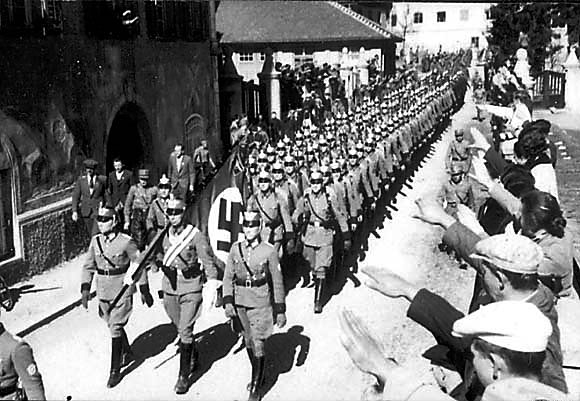
German police entering the
city Imst in Tyrol/Austria on 12 March 1938.
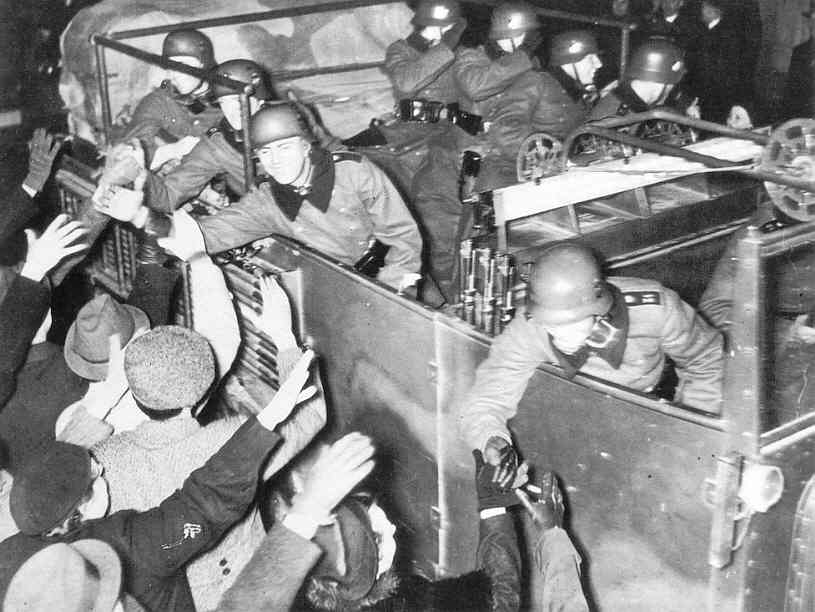
Nazi troops being greeted
by Viennese as they move in to effect the Anschluss with
Austria
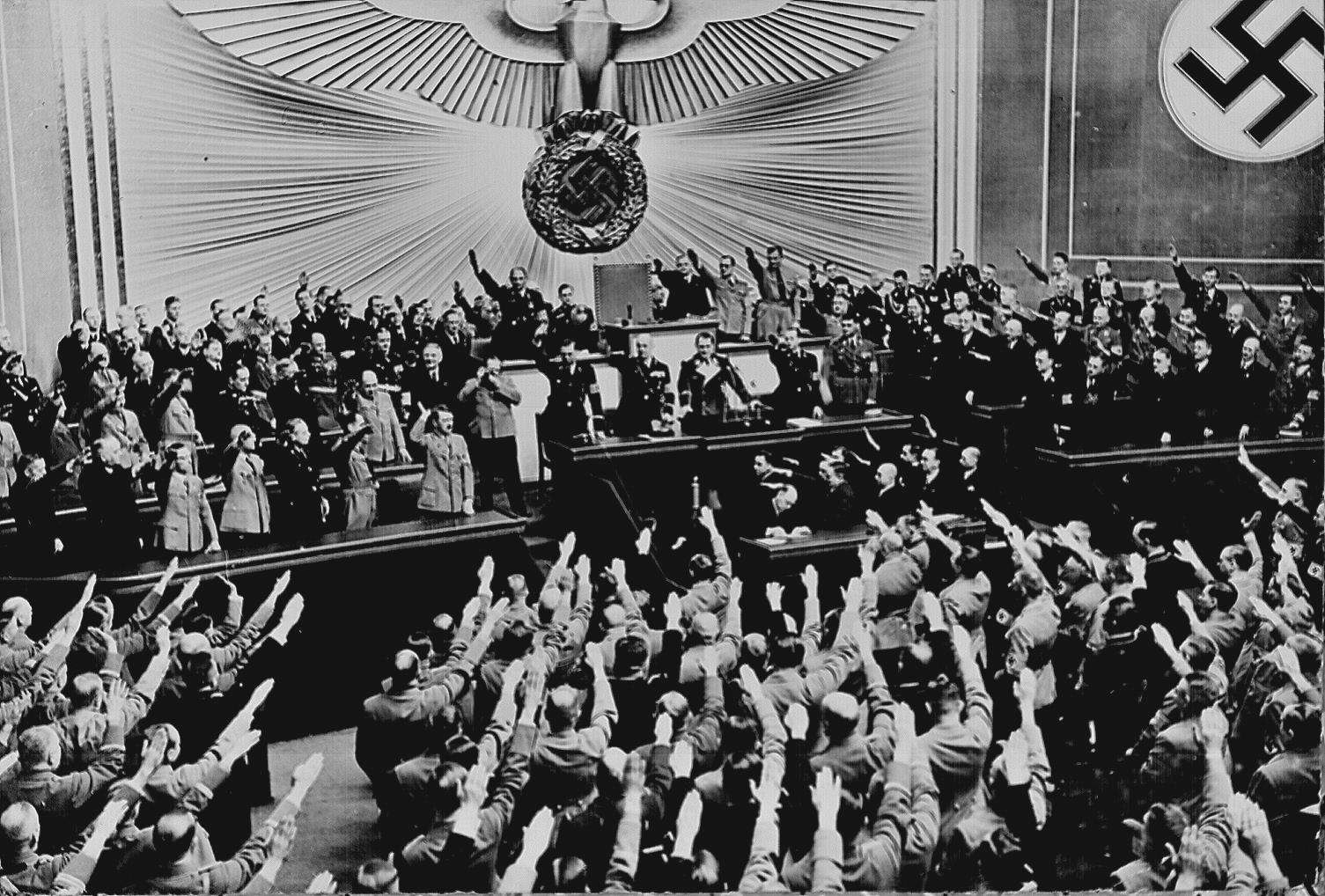
"Hitler accepts the ovation of the Reichstag
after announcing the 'peaceful' acquisition of Austria."
It set the stage to annex the Czechoslovakian
Sudetenland,
largely inhabited by a German- speaking
population." Berlin, March 1938
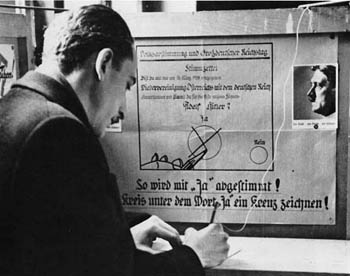
The referendum on 10 April
1938 on the Anschluss in Austria
Propaganda even in the voting
booth
with a poster instructing
voters how to vote "Ja", i.e. "Yes".
Hitler seizes Czechoslovakia ... in stages
|
Chamberlain would have the opportunity soon enough
to make good on his promise – and once again back down in the face of
Hitler’s aggressive moves. Hitler now set his eyes on the Germans
living in the mountainous borderlands of Czechoslovakia (the region
known as Sudetenland). Hitler began to claim loudly that the Czechs
were mistreating the Germans of the Sudetenland (totally untrue) and he
was thus forced to have to deal with this situation. However,
Czechoslovakia’s military defenses (aimed primarily against Germany,
but also the new Poland) were well dug in there, and Czechoslovakia’s
battle-ready forty infantry divisions would have offered very effective
and very embarrassing resistance to any aggressions on the part of
Hitler.
But to avoid a mounting international
crisis, Chamberlain agreed to meet in September (1938) with Hitler (and
Mussolini) in Munich, to seek a peaceful resolution to this (non)
crisis, not knowing that officers in the German high command were
secretly making plans to depose Hitler before he dragged the country
into an unwanted war.
Then as a result of the discussions held
in Munich concerning this Czechoslovakian crisis (to which the
Czechoslovakian leadership itself was not even invited), Chamberlain
was pleased to offer the world a peaceful solution, one that would
avoid dragging Europe into another war. Hitler would be allowed to take
over the Sudetenland (and Czechoslovakia's mountain border defenses),
with Hitler's promise that this was all of Czechoslovakia that he
wanted.
So happy was the European world (except the
outraged Czechs, whose beloved President Edvard Beneš resigned rather
than agree to the terms forced on his country) that Chamberlain had
"saved Europe from another war," that talk grew of awarding him the Nobel
Peace Prize!
And most tragically for the world, it also
forced the German High command to cancel its proposed removal of Hitler
– as Hitler's acquisition of Sudetenland again made him the supreme
hero of the German people.
|
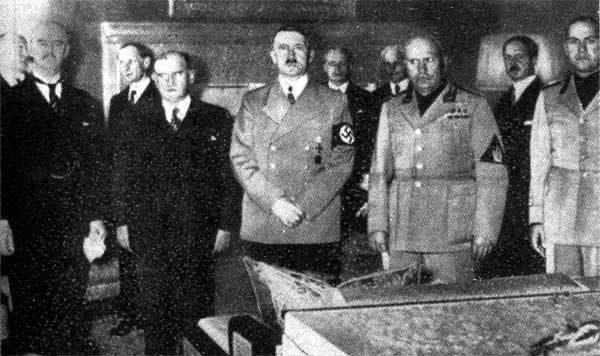
Before signing the Munich
agreement. From left to right: Chamberlain,
Daladier, Hitler, Mussolini,
Ciano
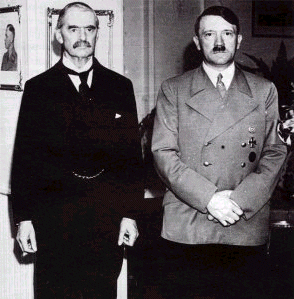
Adolf Hitler and Neville
Chamberlain after the Munich Agreement
which gave Czechoslovakia's defensive borderlands to
Hitler
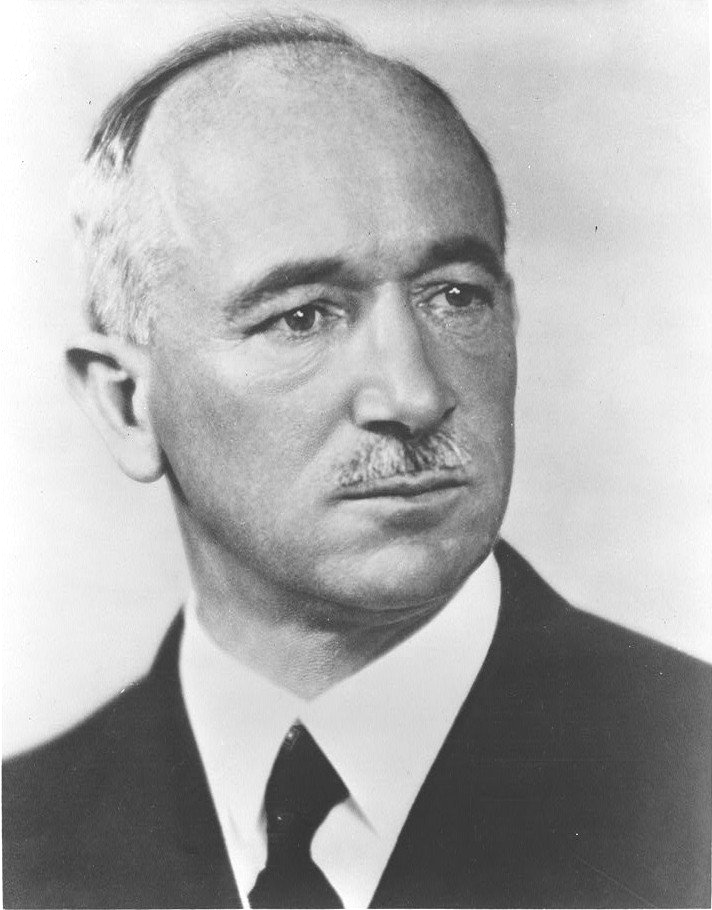
Edvard Beneš – President
of Czechoslovakia
He was not invited by either
Hitler or Chamberlain to participate or have a voice
in the dismembering of his
country by both enemy and "allied" nations
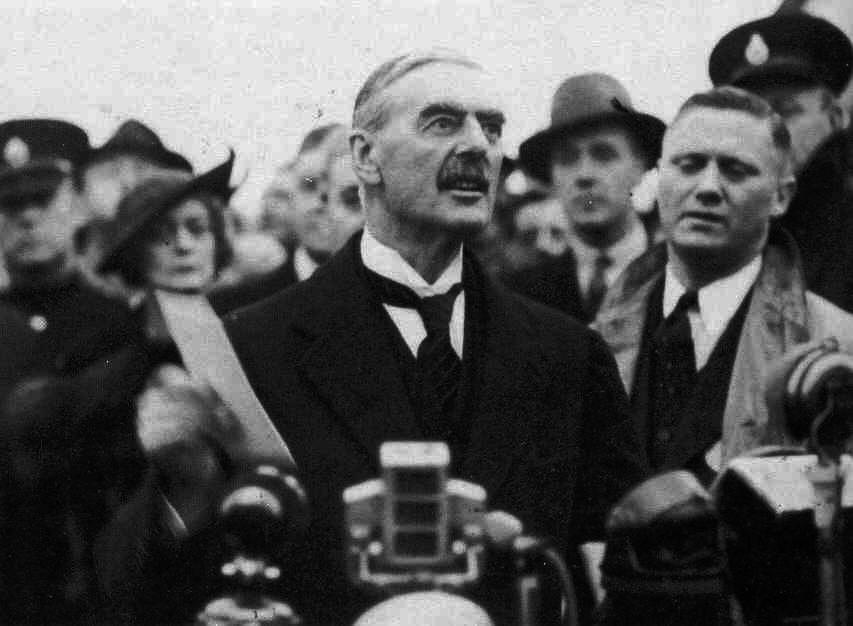
Neville Chamberlain, on his
return from meeting with Hitler,
announcing "Peace for our Time" – Sept.
30, 1938
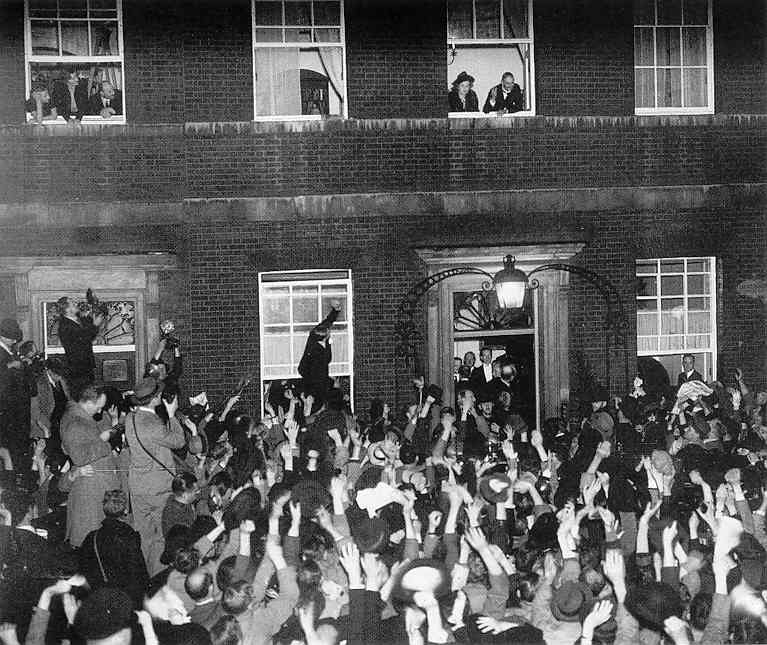
Appreciative crowds hail
the British Prime Minister for having brought them "Peace in Our
Time."
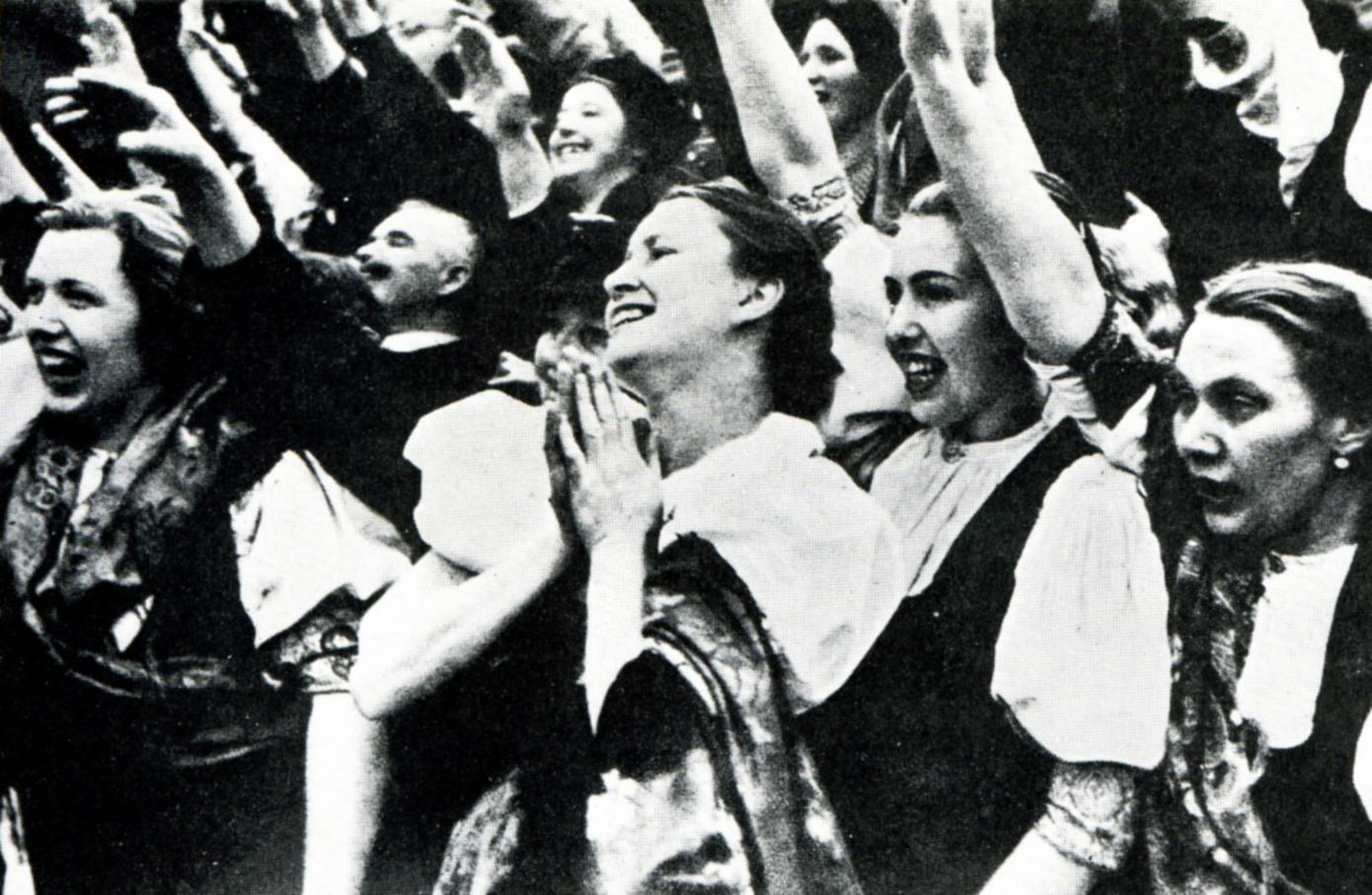
Ecstatic Sudeten women greeting
arriving German troops
|
Hitler completes the absorption of Czechoslovakia
Of course Hitler had no intention of
keeping his promise to Chamberlain, and in March of 1939 – at the
"invitation" of Czechoslovakia's new leadership (the browbeaten
President Hacha) – Hitler sent his troops to take over all of
Czechoslovakia.
The world was shocked, but again did
nothing. Chamberlain again repeated his promise that he would protect
Germany's neighbors (Poland the next obvious target) – with the threat
of a declaration of war against Germany if Hitler were to make such a
move.
But by this time few believed that
Chamberlain would – or even at this point could – deliver in a
meaningful way on such a threat.
|
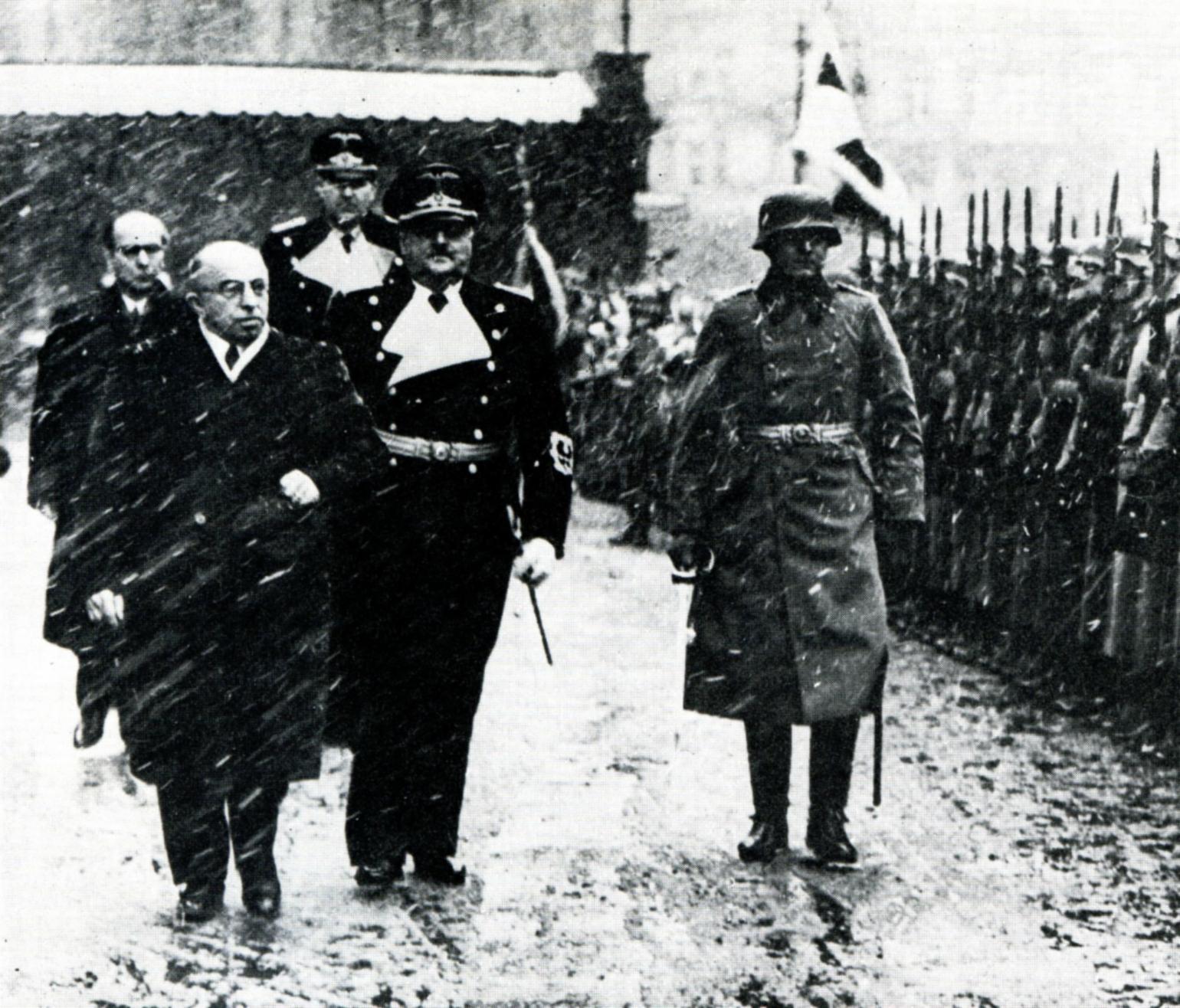
A weary Emil Hácha,
recently elevated to Czech presidency, is brought to Germany
to be browbeaten by Hitler
into the surrender of his country to Nazi control – 1939
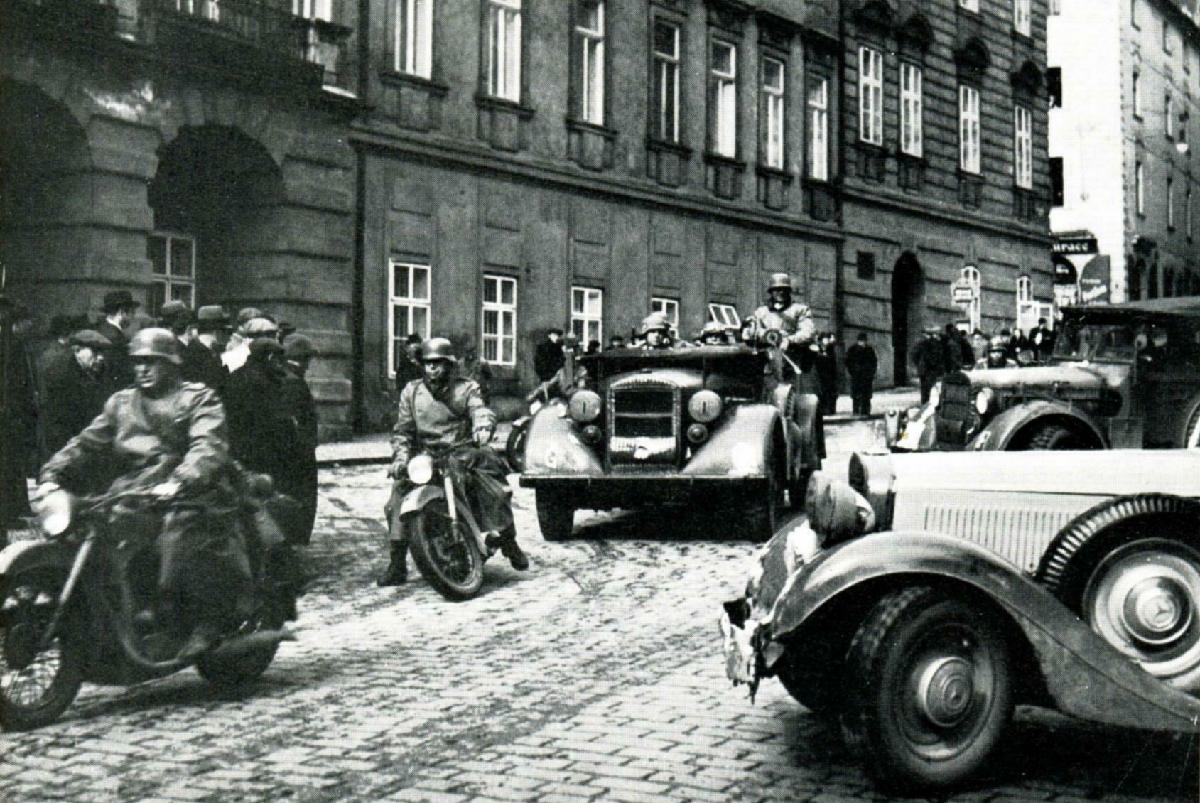
Germans arriving in Prague
in front of the Hradčany Castle
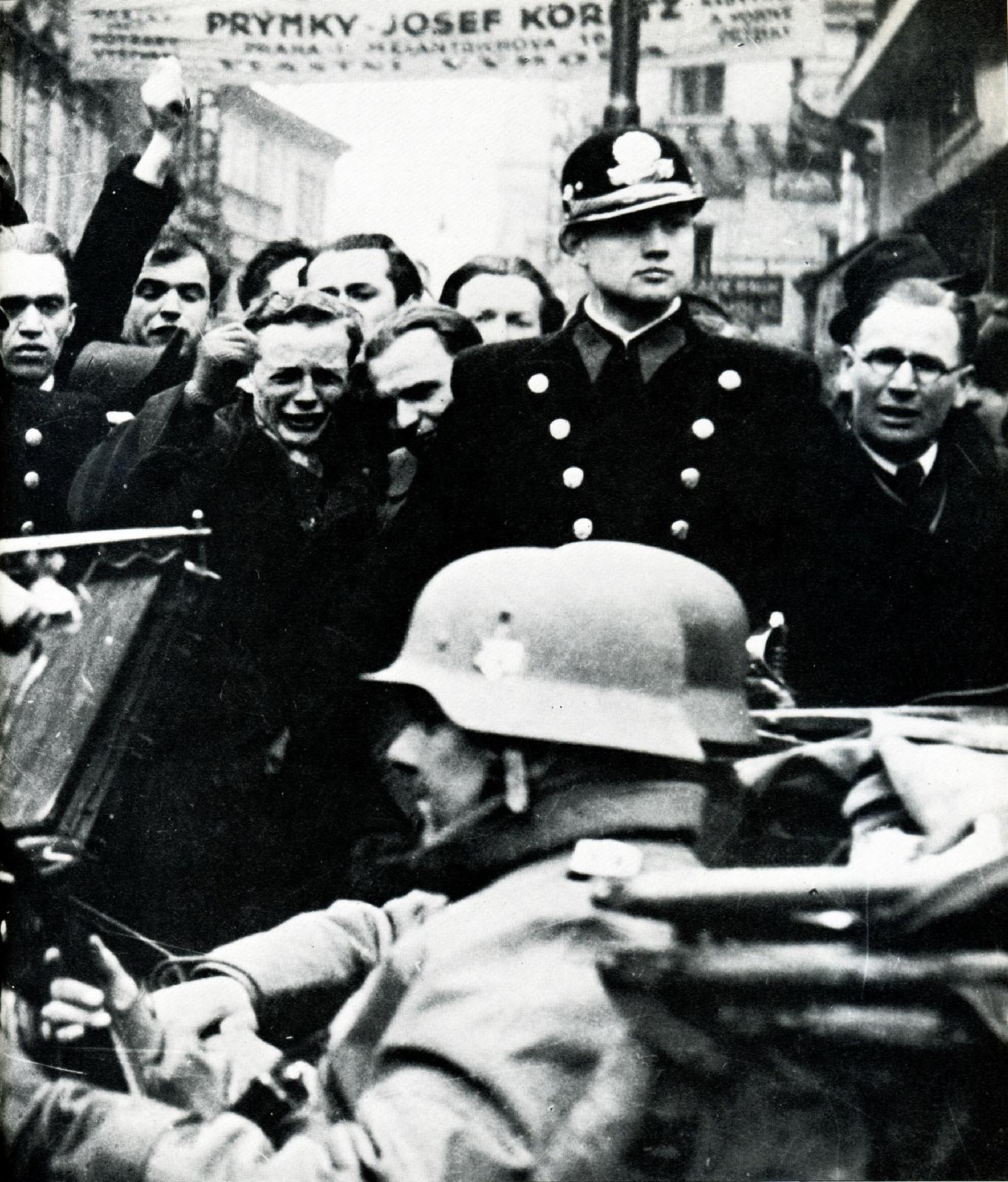
March 15, 1939 – Shocked
and angry Czechs reacting to the Nazi takeover
of the whole of Czechoslovakia
and its capital, Prague
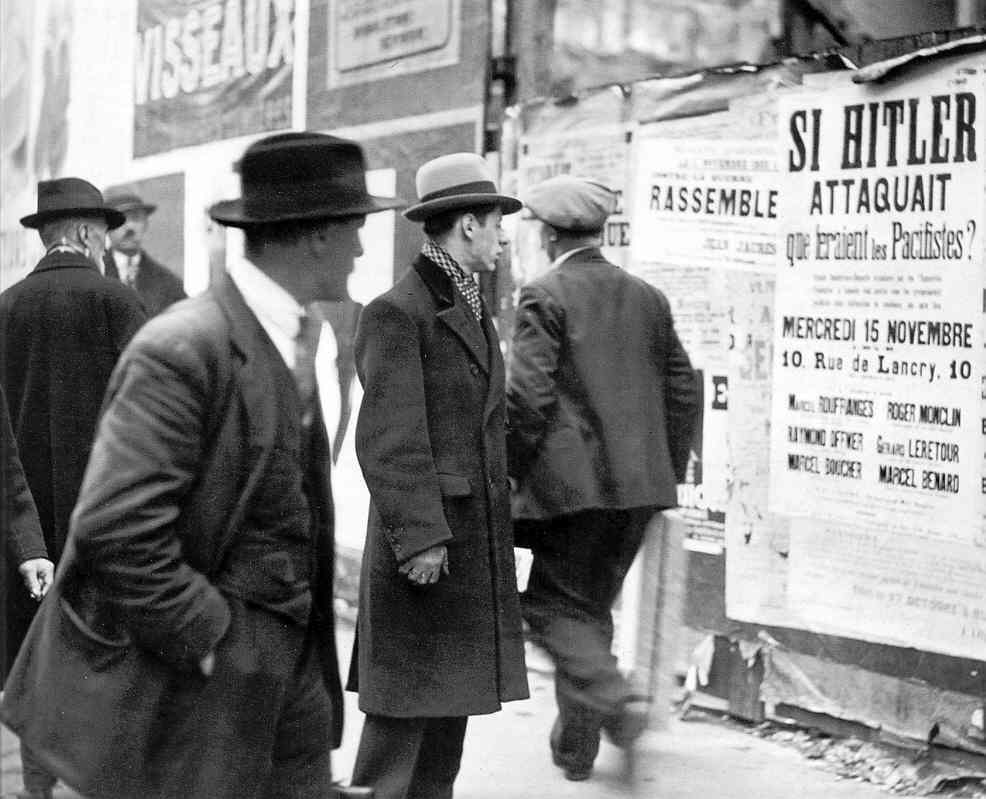
"If Hitler were to attack what would
the
Pacifists do?"
French grow increasingly
concerned about Hitler


|
THE NAZI ASSAULT ON THE JEWS INTENSIFIES
|
|
|
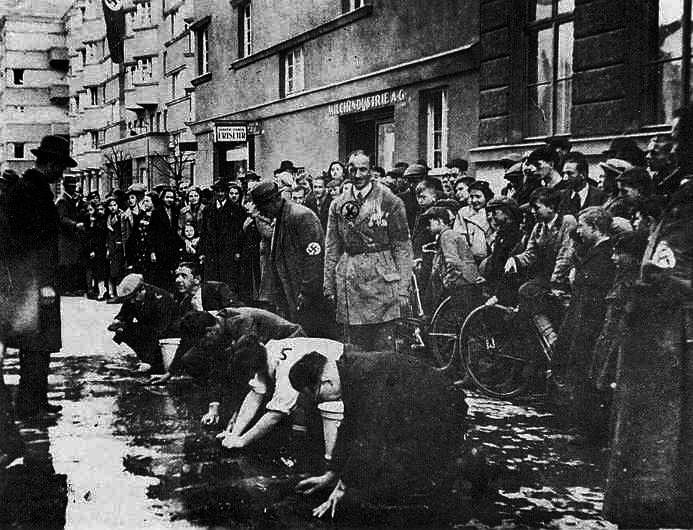
Jewish persecution begins
in Austria as Jews are made to scrub
pro-Austrian slogans from streets – March 1938
|
Kristallnacht – November 9, 1938 (The night of broken glass)
November 7, 1938 – Herschel Grynszpan, a young Polish Jew in Paris,
shot and killed the German 3rd secretary in the embassy there,
providing the Nazi government the excuse to retaliate 2 days later
against Jews everywhere in a night of terror known as Kristallnacht –
for all the glass windows of Jewish stores destroyed. Synagogues
were burned, 7,500 shops were wrecked, perhaps as many as a hundred
Jews were killed, thirty thousands were arrested and fines totaling a
billion marks were levied on the Jews. Also all the insurance
money paid to the Jews for the damage of the Kristallnacht (5 million
marks) was confiscated by the government.
|
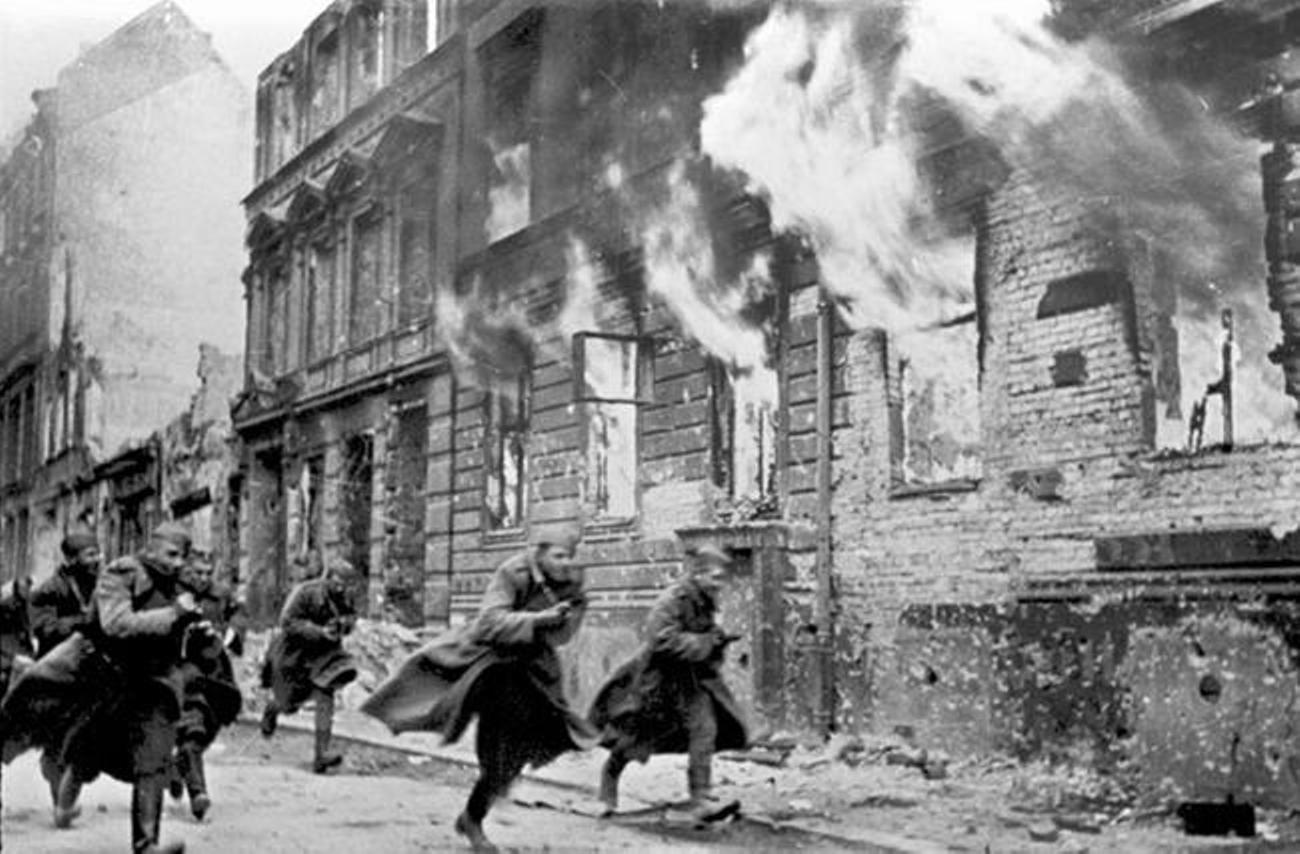
Kristallnacht – the day after (November
10,
1938)
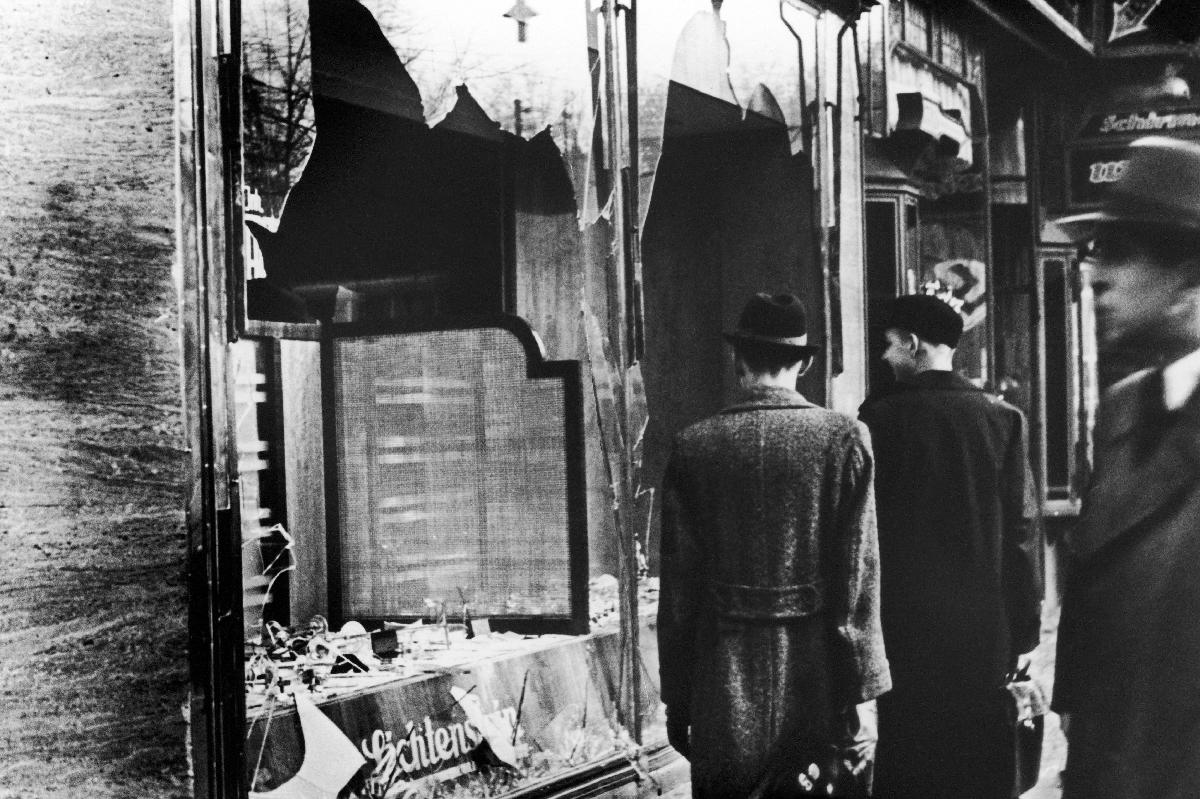
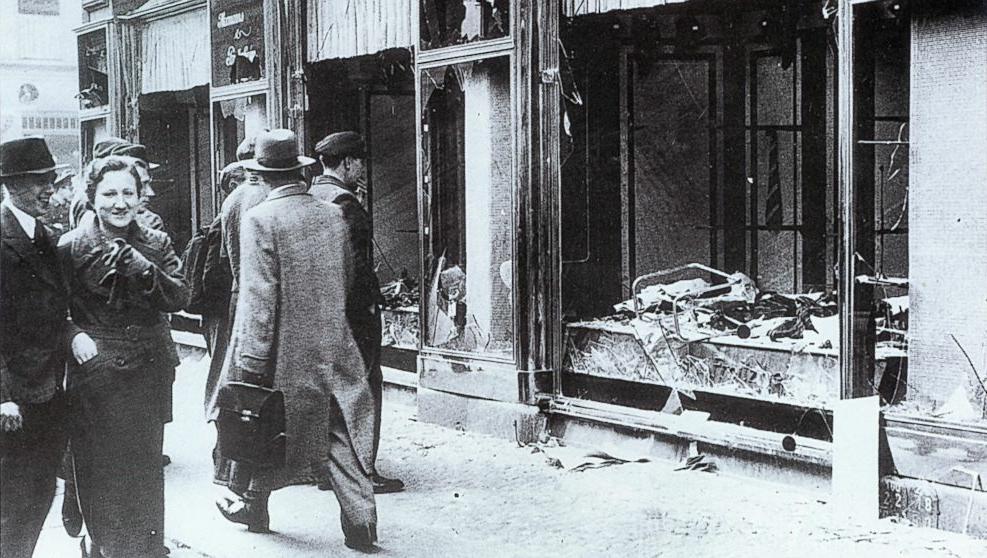
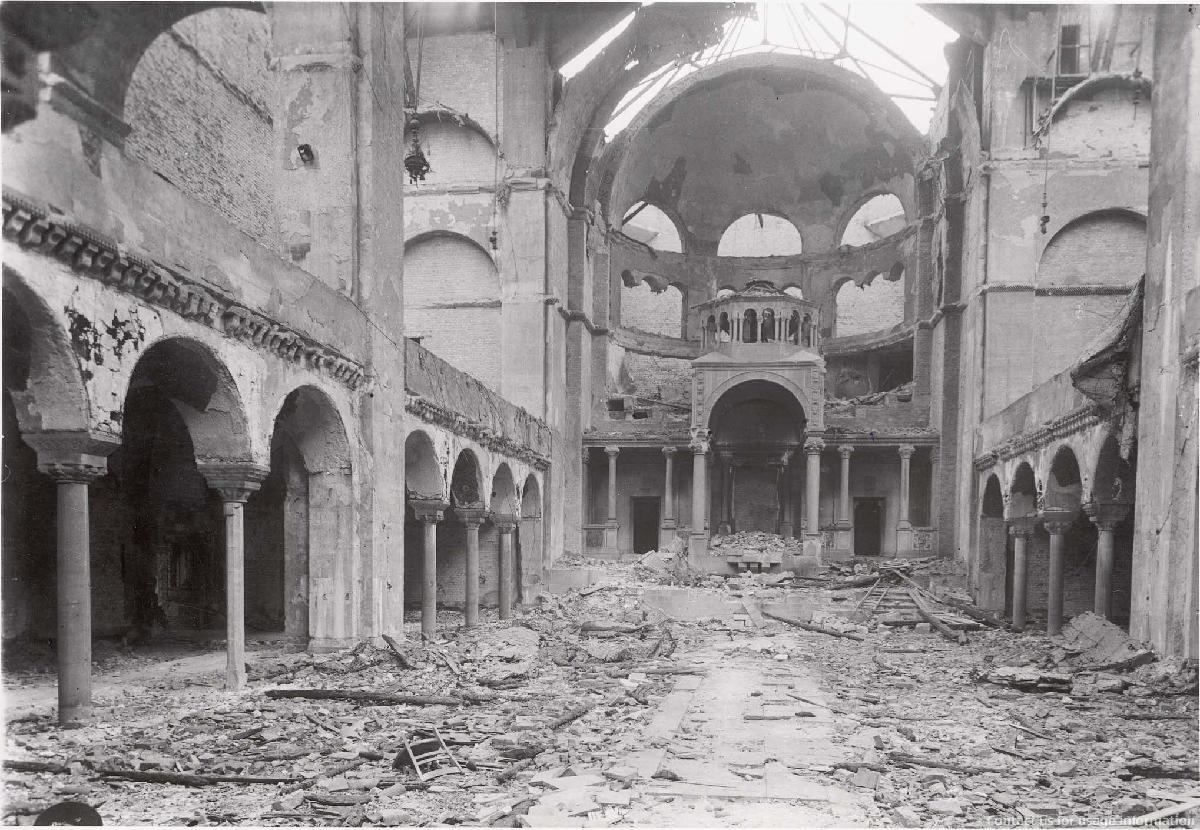
Kristallnacht – November
1938
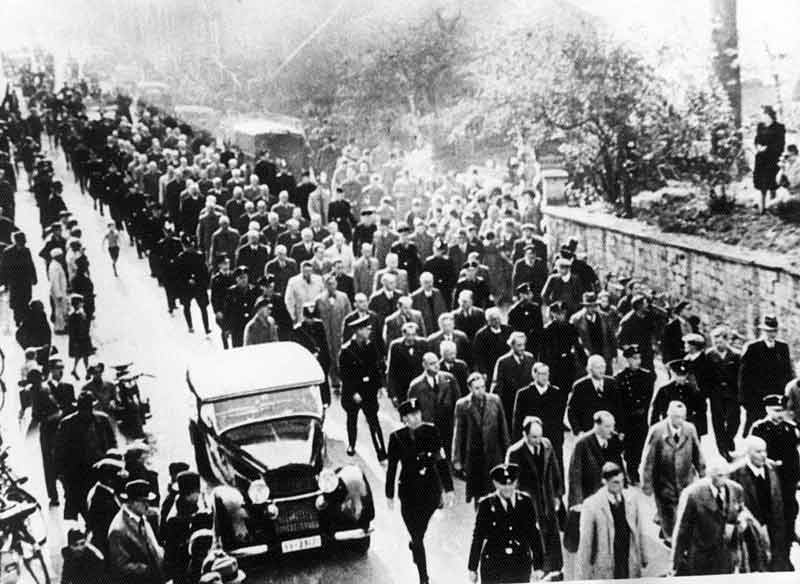
Jewish arrests in
Baden-Baden, Germany (November
10), as a follow-up on
Kristallnacht
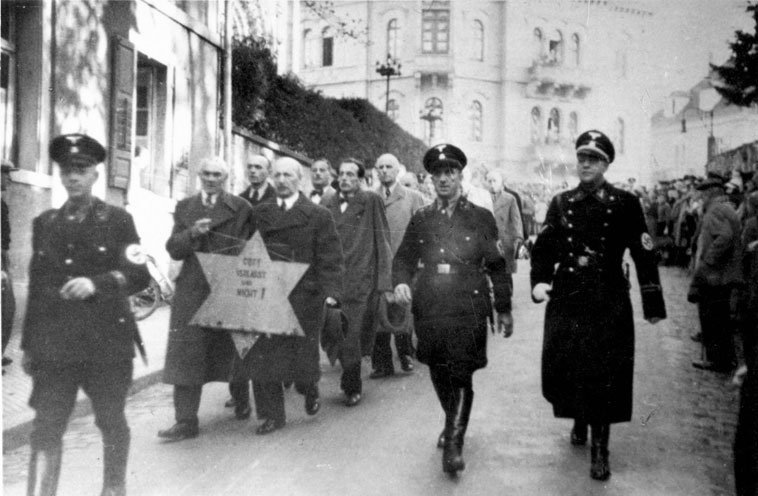
Jews being led
away (November
10)
to Dachau,
Buchenwald or Sachsenhausen
Concentration Camps
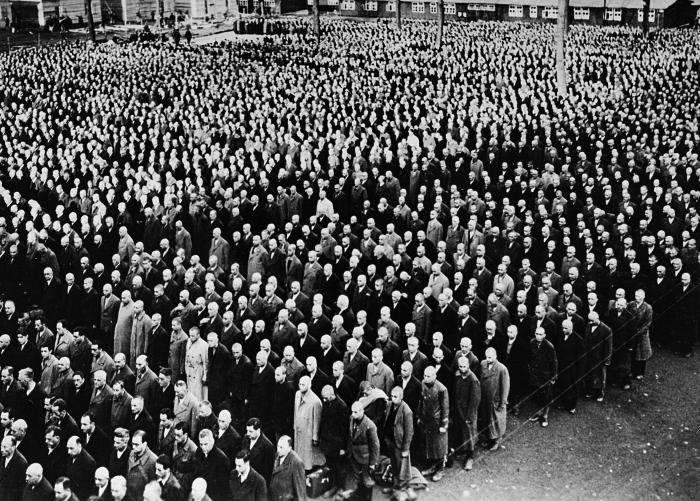
Jews arrested during
Kristallnacht line up for roll call at the Buchenwald Concentration
Camp
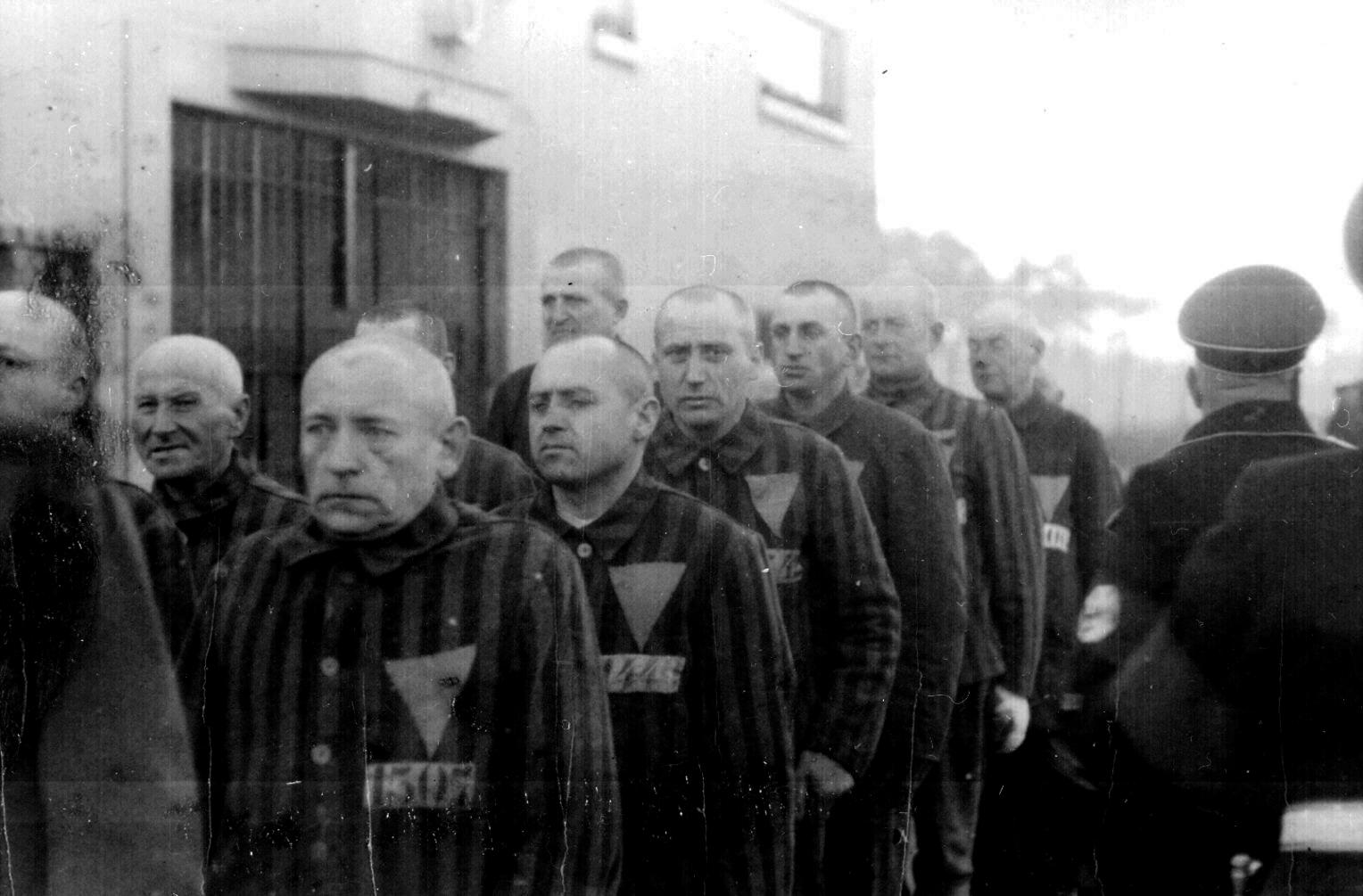
Prisoners in the concentration
camp at Sachsenhausen, Germany, December 19, 1938.
National Archives
242-HLB-3609-25


 The attractiveness of the European
Dictators
The attractiveness of the European
Dictators
 Stalin's Communist "command" economy
(or "state
capitalism")
Stalin's Communist "command" economy
(or "state
capitalism")
 Hitler's "New Order" (Neuordnung)
Hitler's "New Order" (Neuordnung) Italy's Mussolini
Italy's Mussolini France and England seem to have little will to oppose the dictators
France and England seem to have little will to oppose the dictators The Spanish Civil
War
(1936-1939)
The Spanish Civil
War
(1936-1939) Japanese
imperialism in
Asia
Japanese
imperialism in
Asia The expansion of Hitler's Nazi empire goes unchallenged
The expansion of Hitler's Nazi empire goes unchallenged Nazi assault on the Jews intensifies
Nazi assault on the Jews intensifies America retreats into a deep spirit of
isolationism
America retreats into a deep spirit of
isolationism








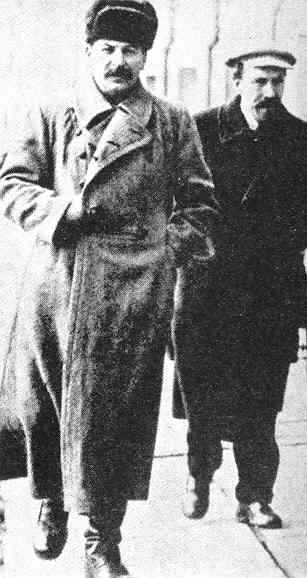
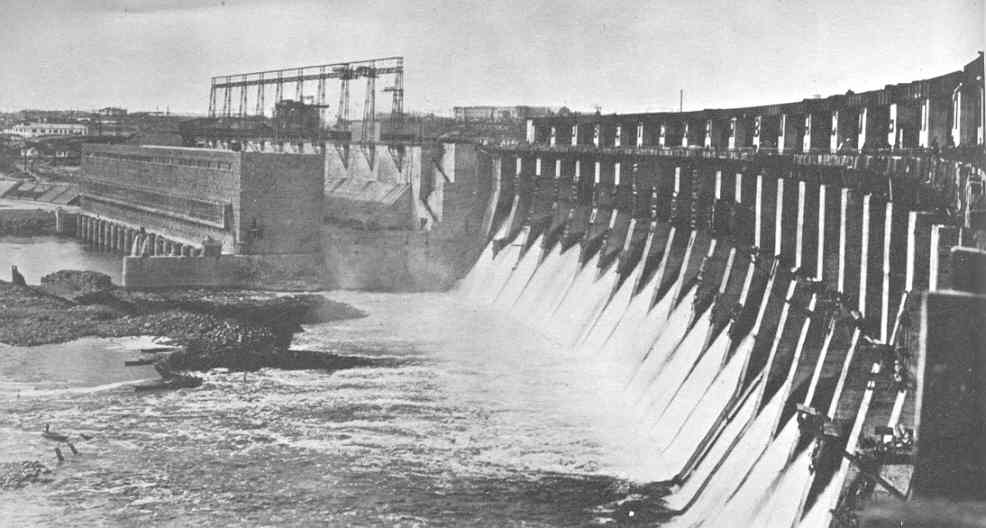
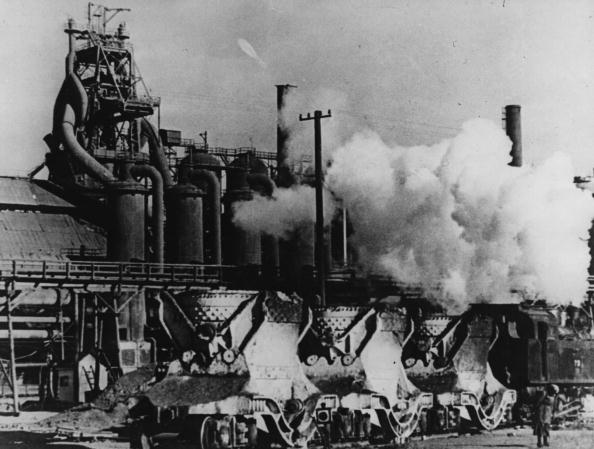
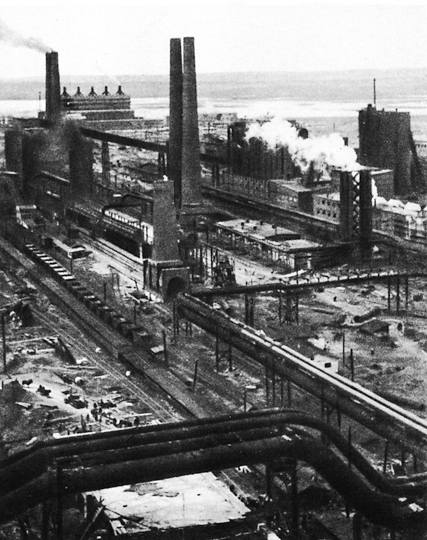
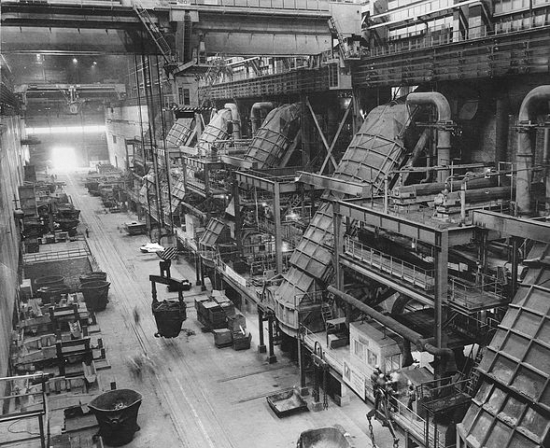
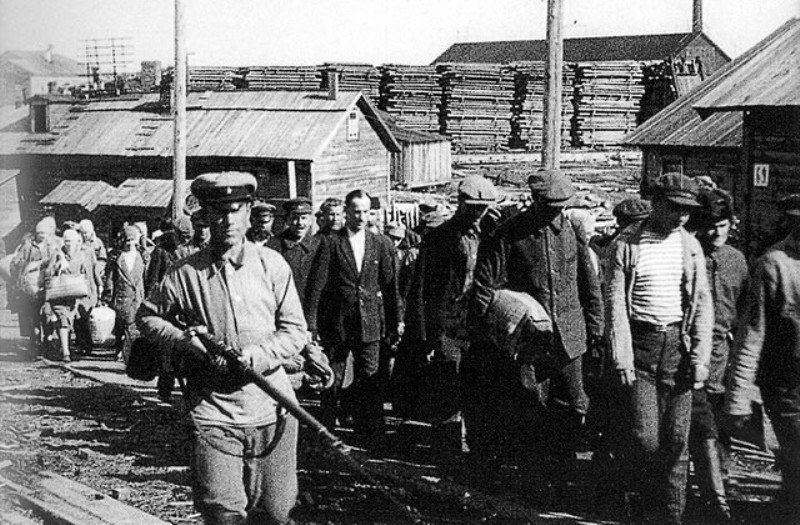
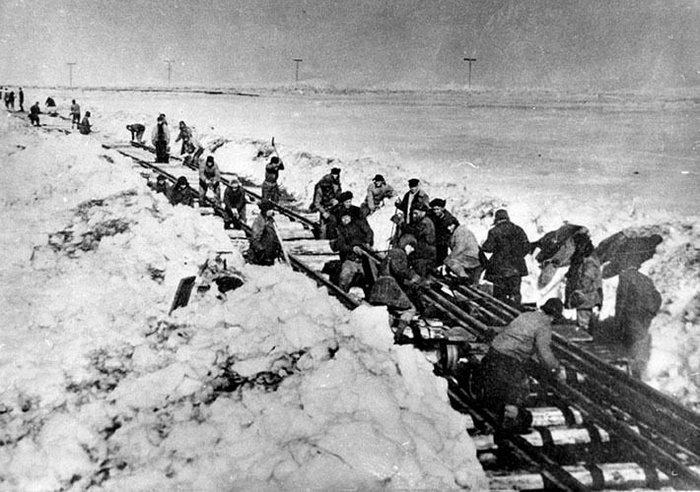
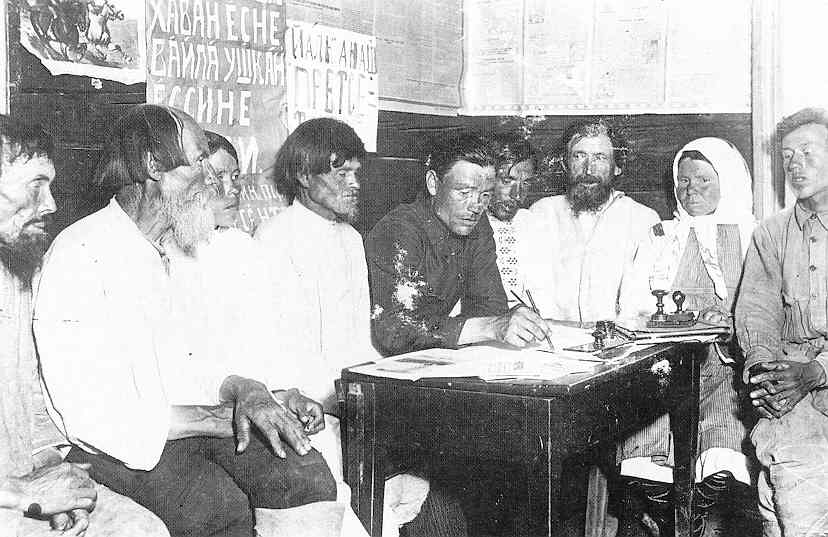
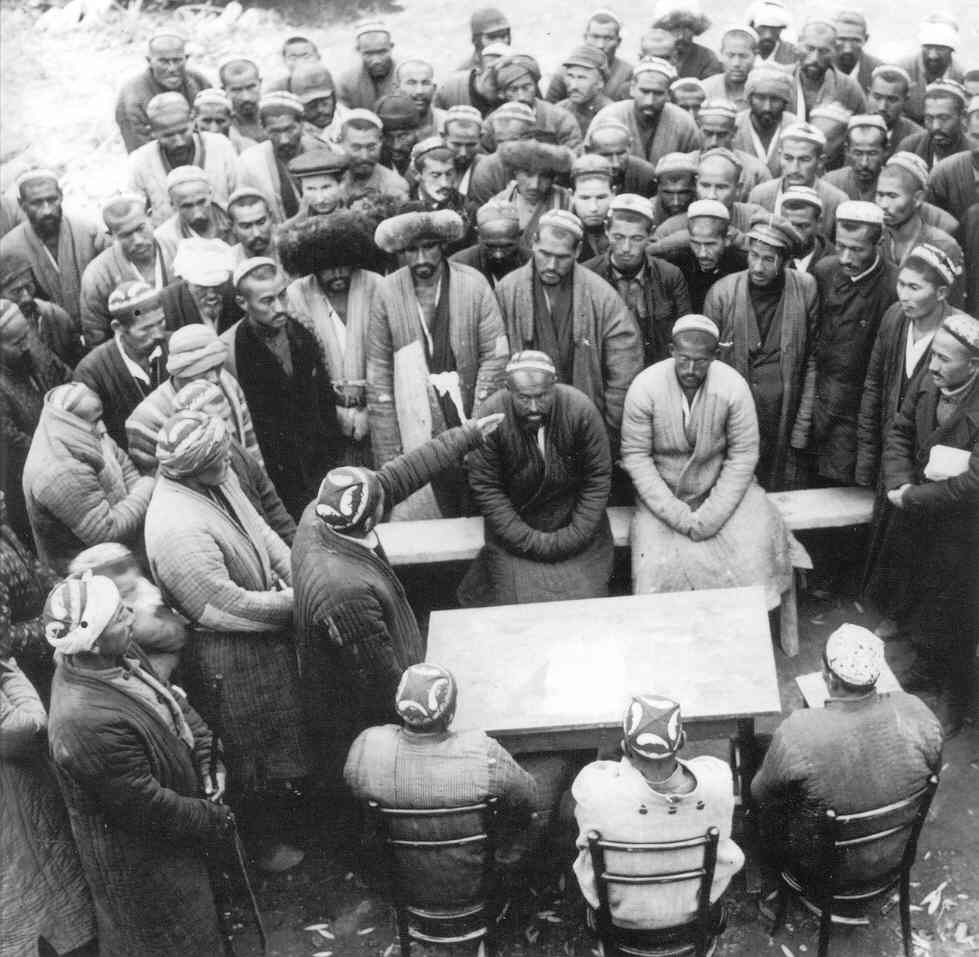
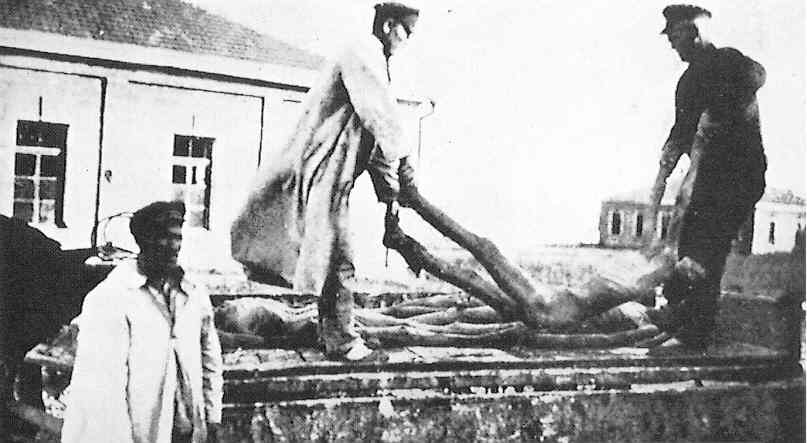
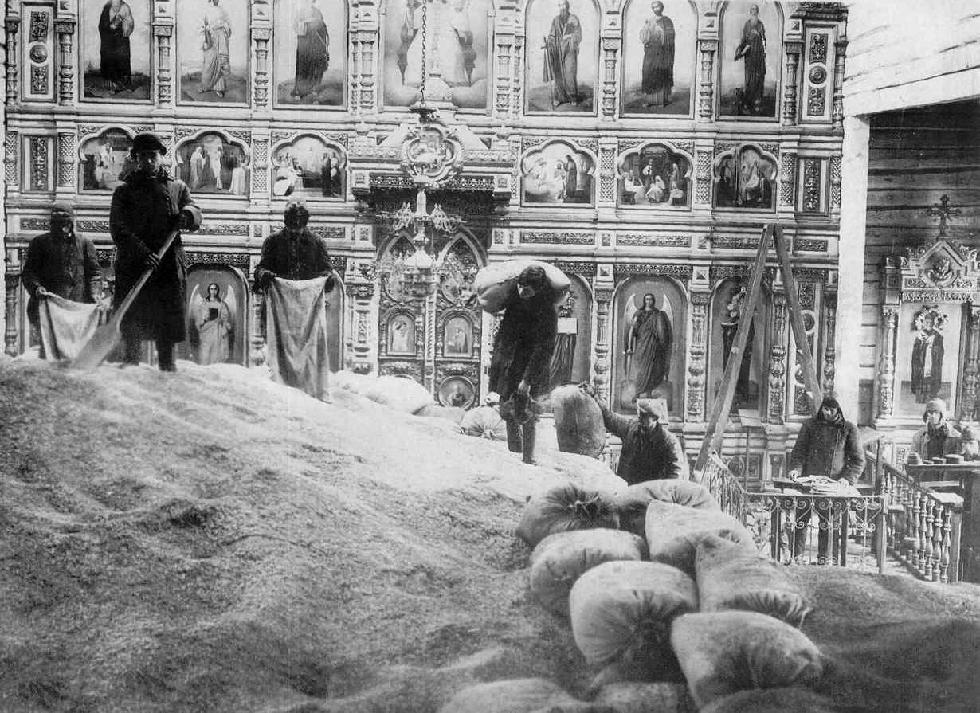
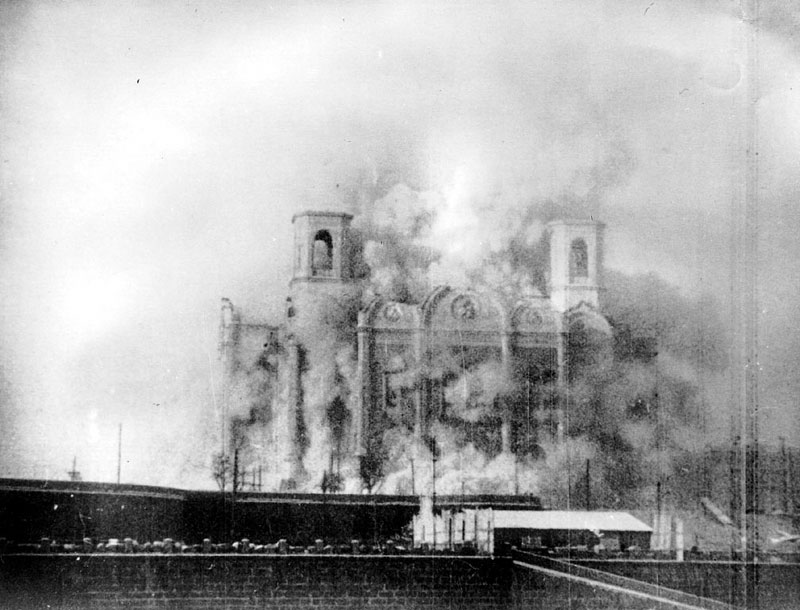
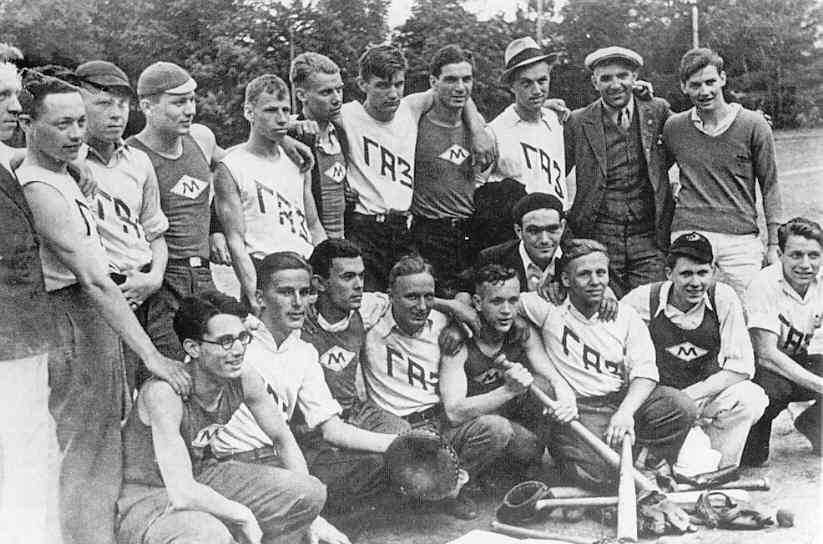
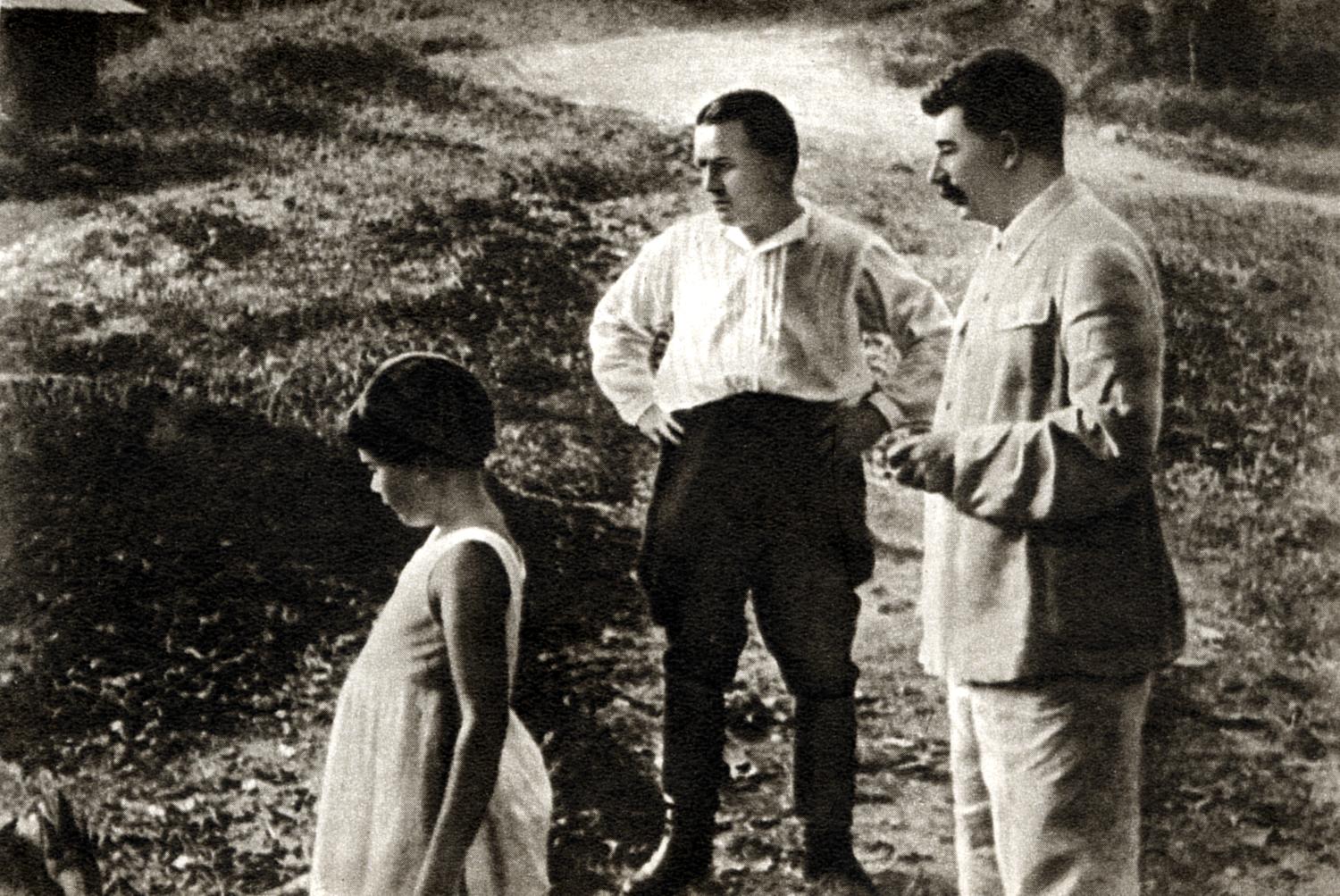
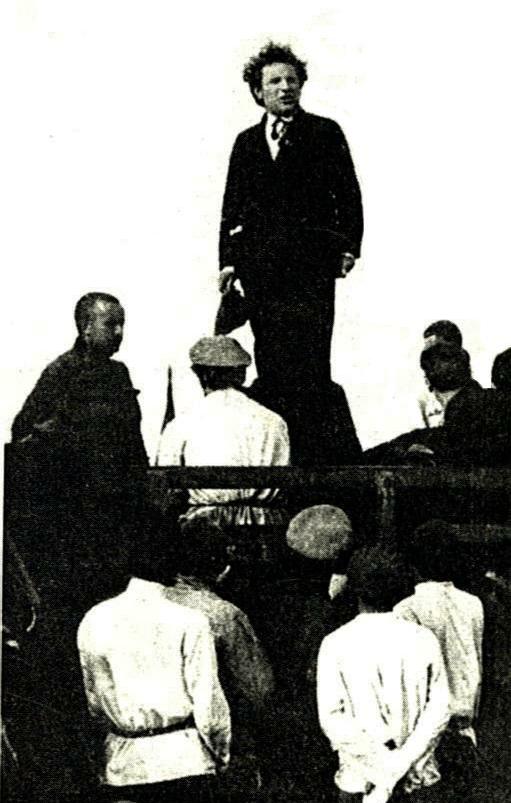
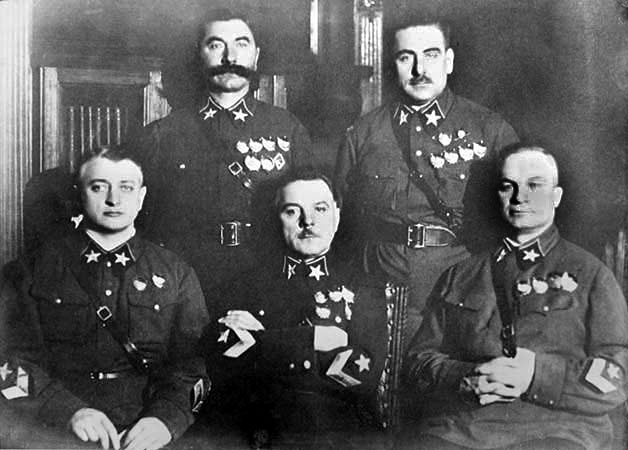
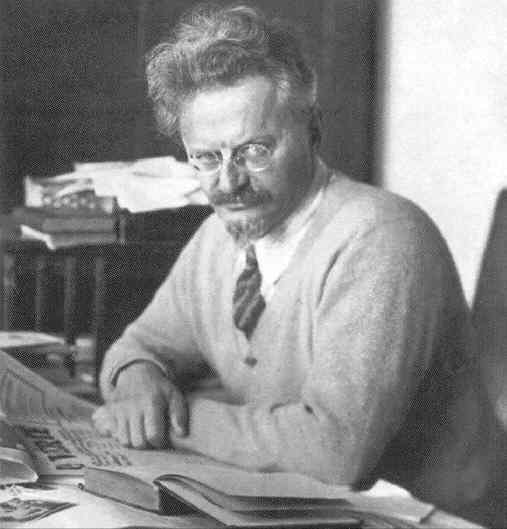
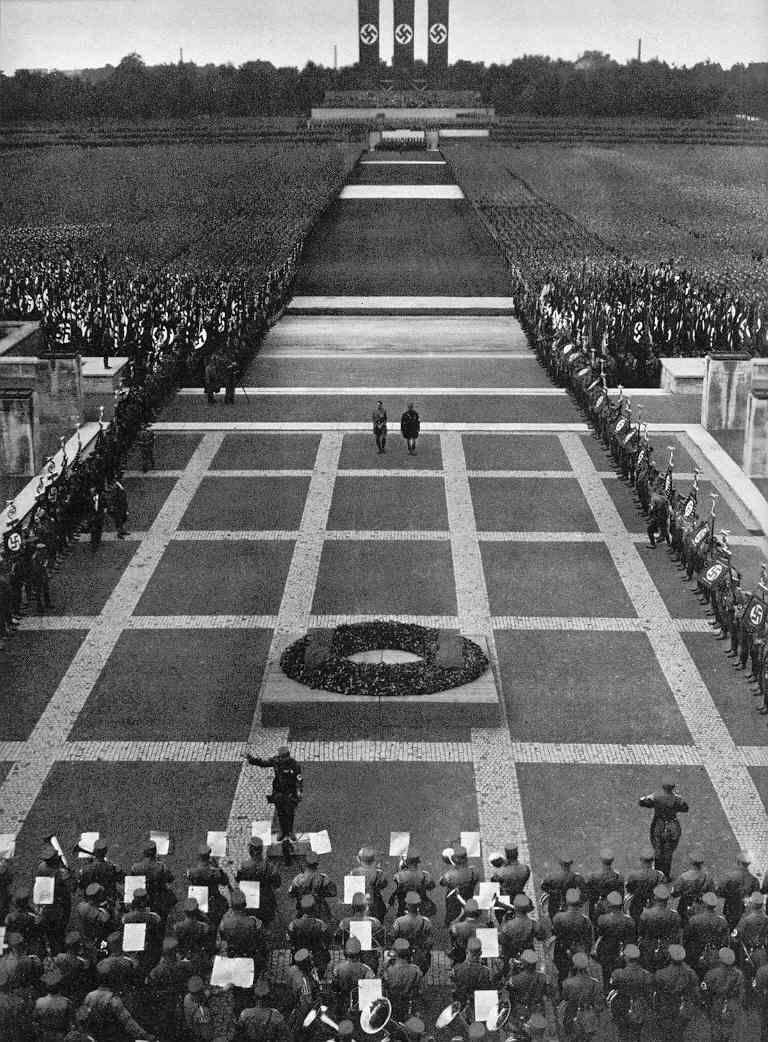
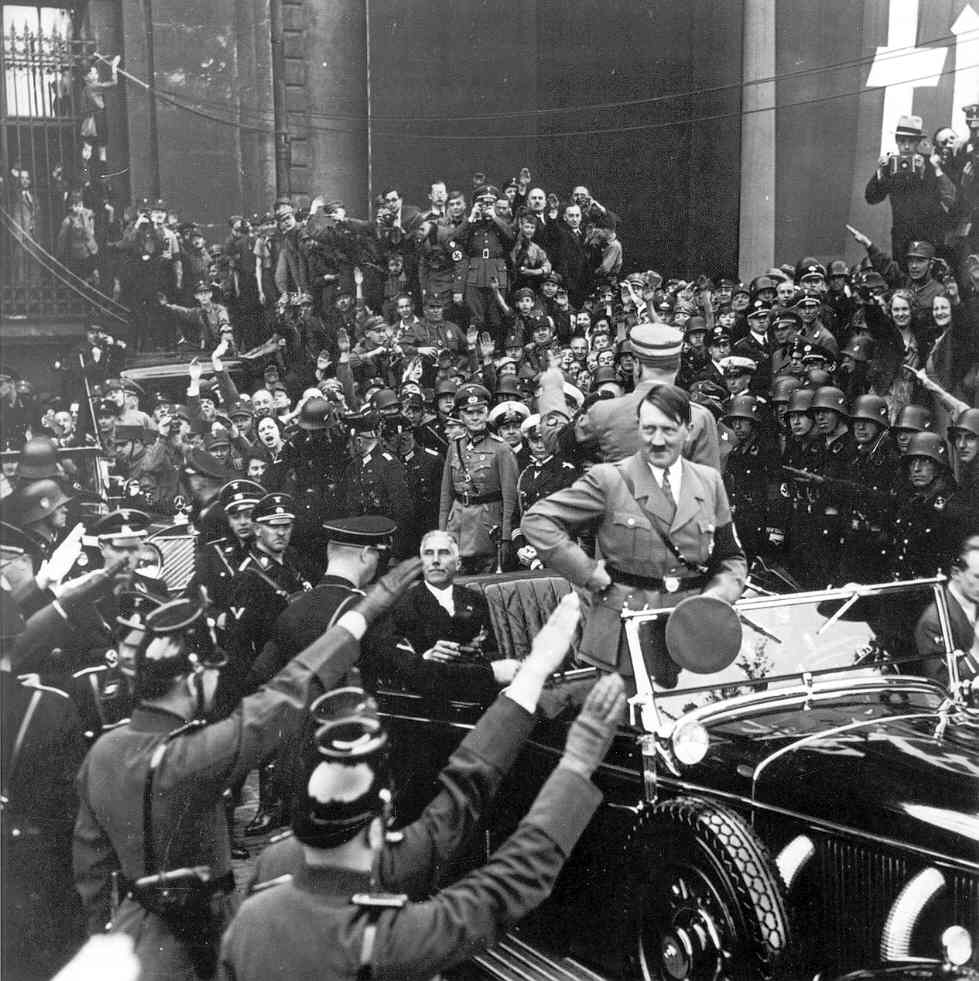
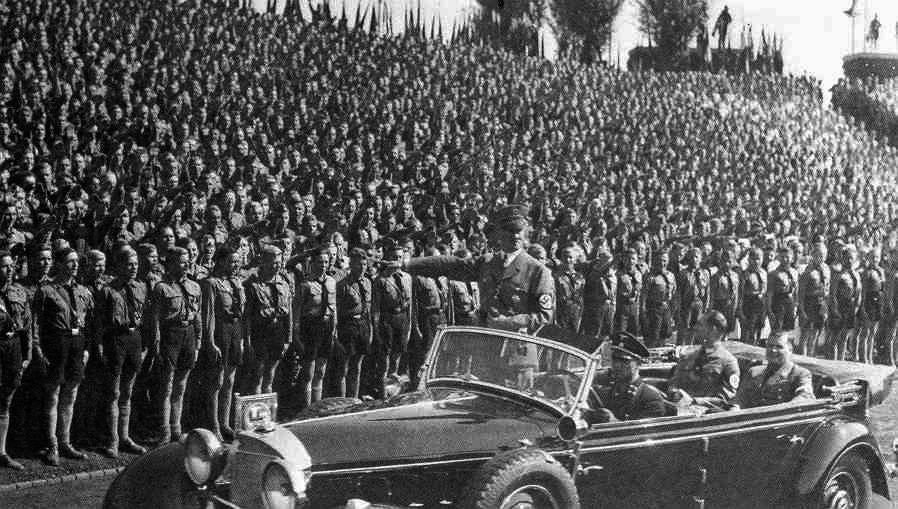
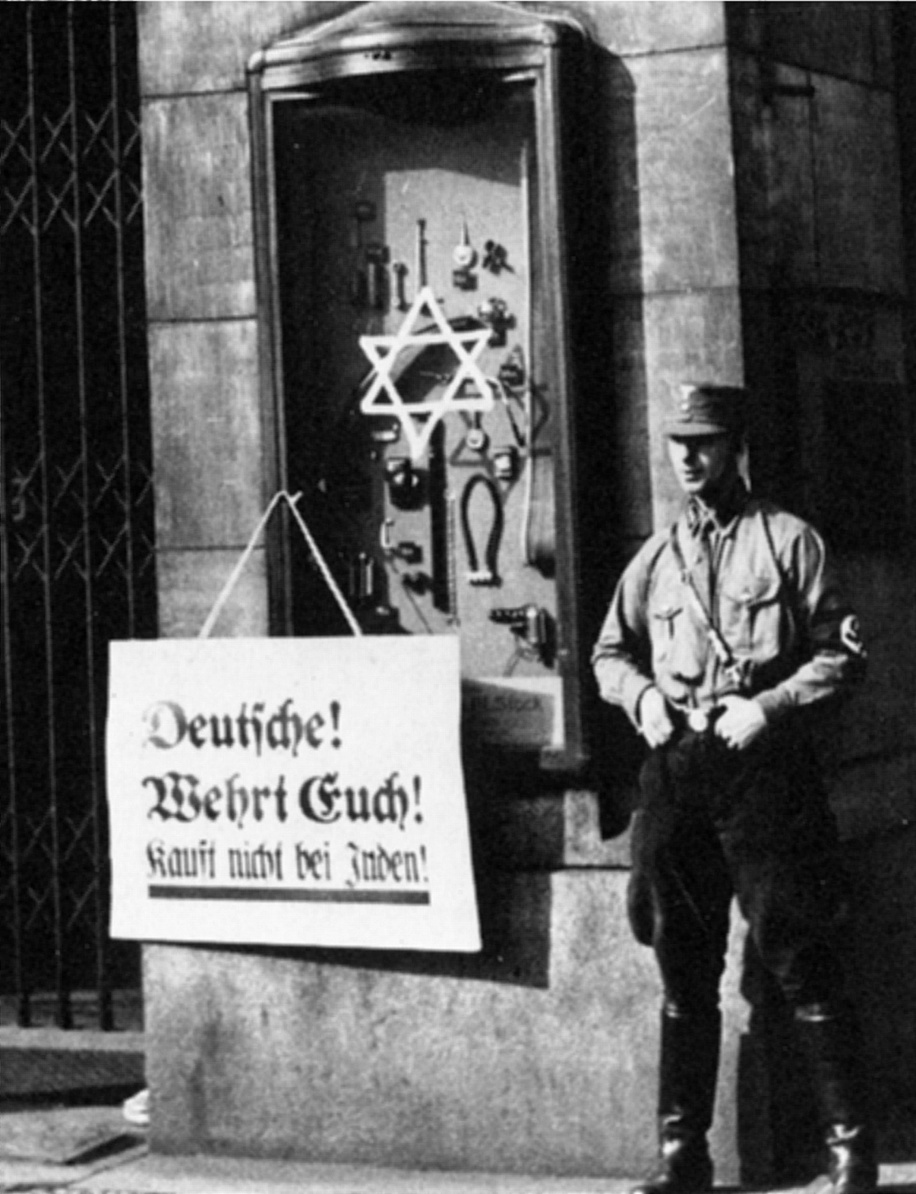
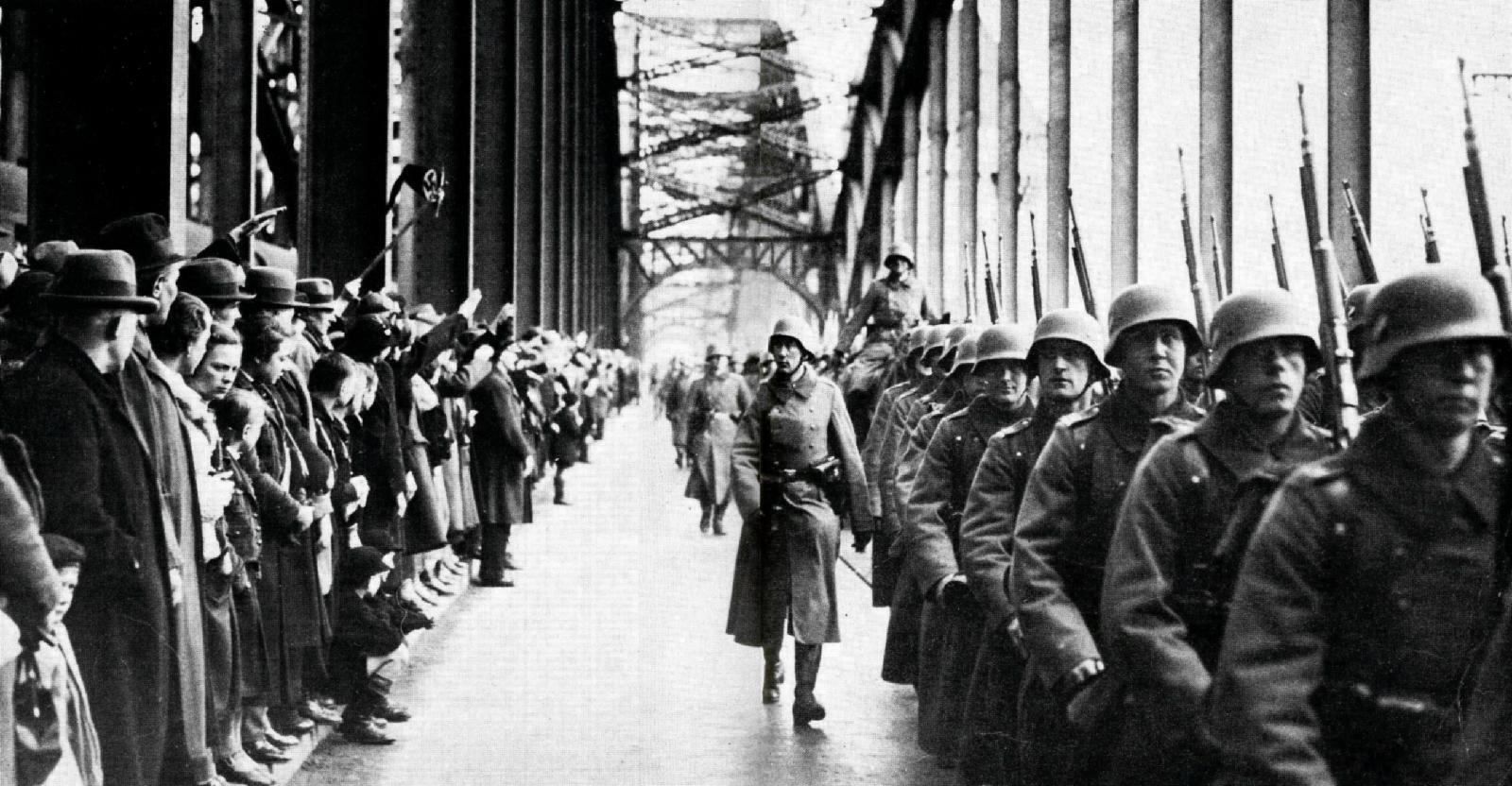
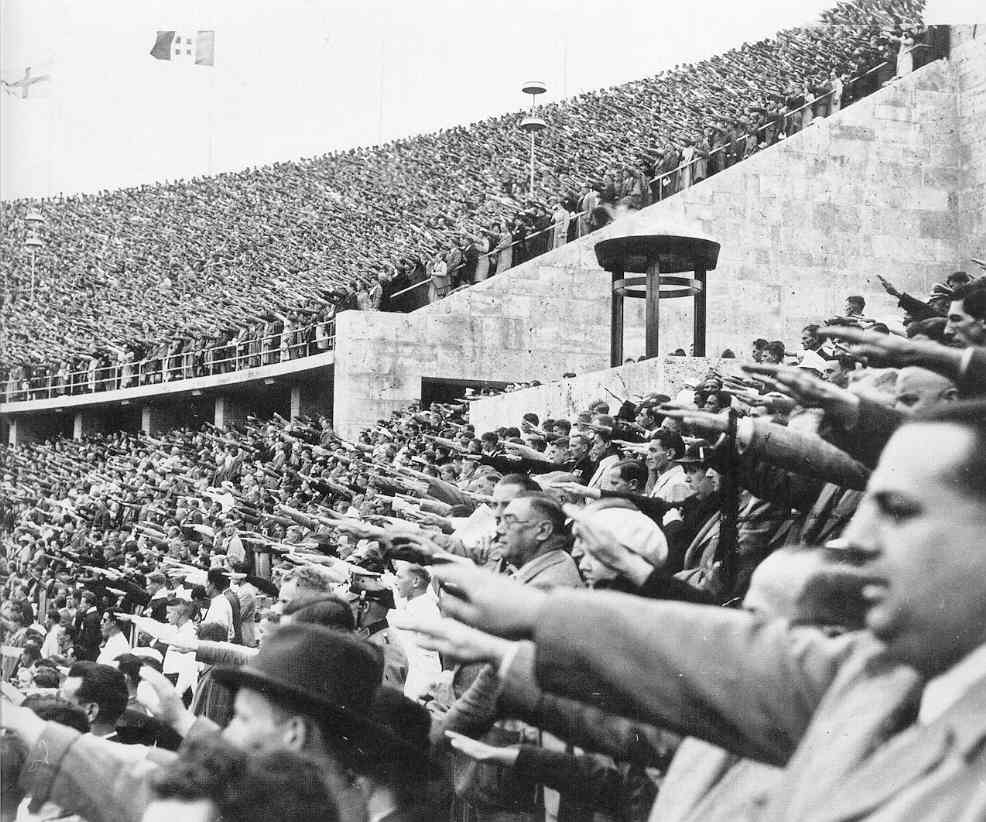
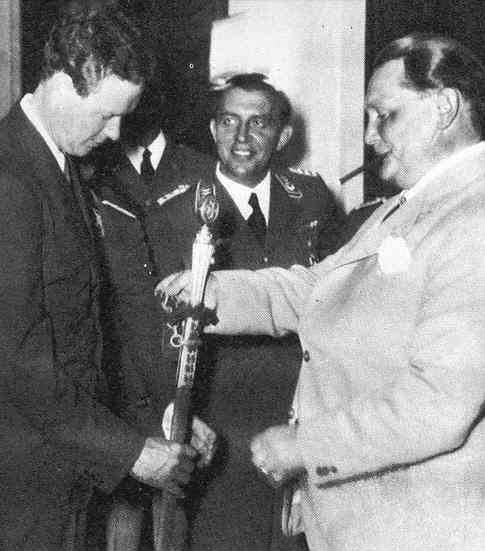
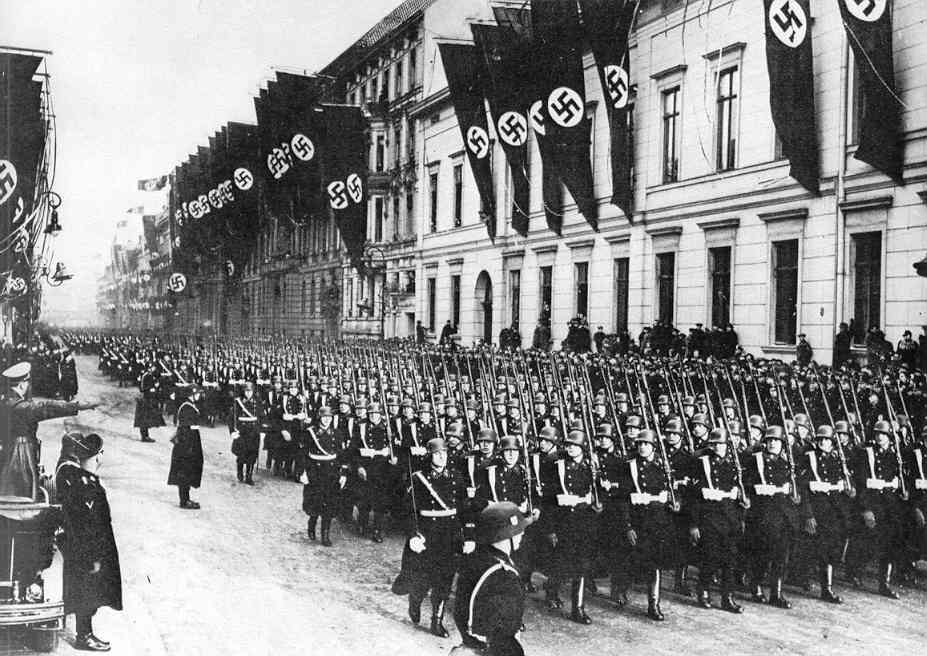
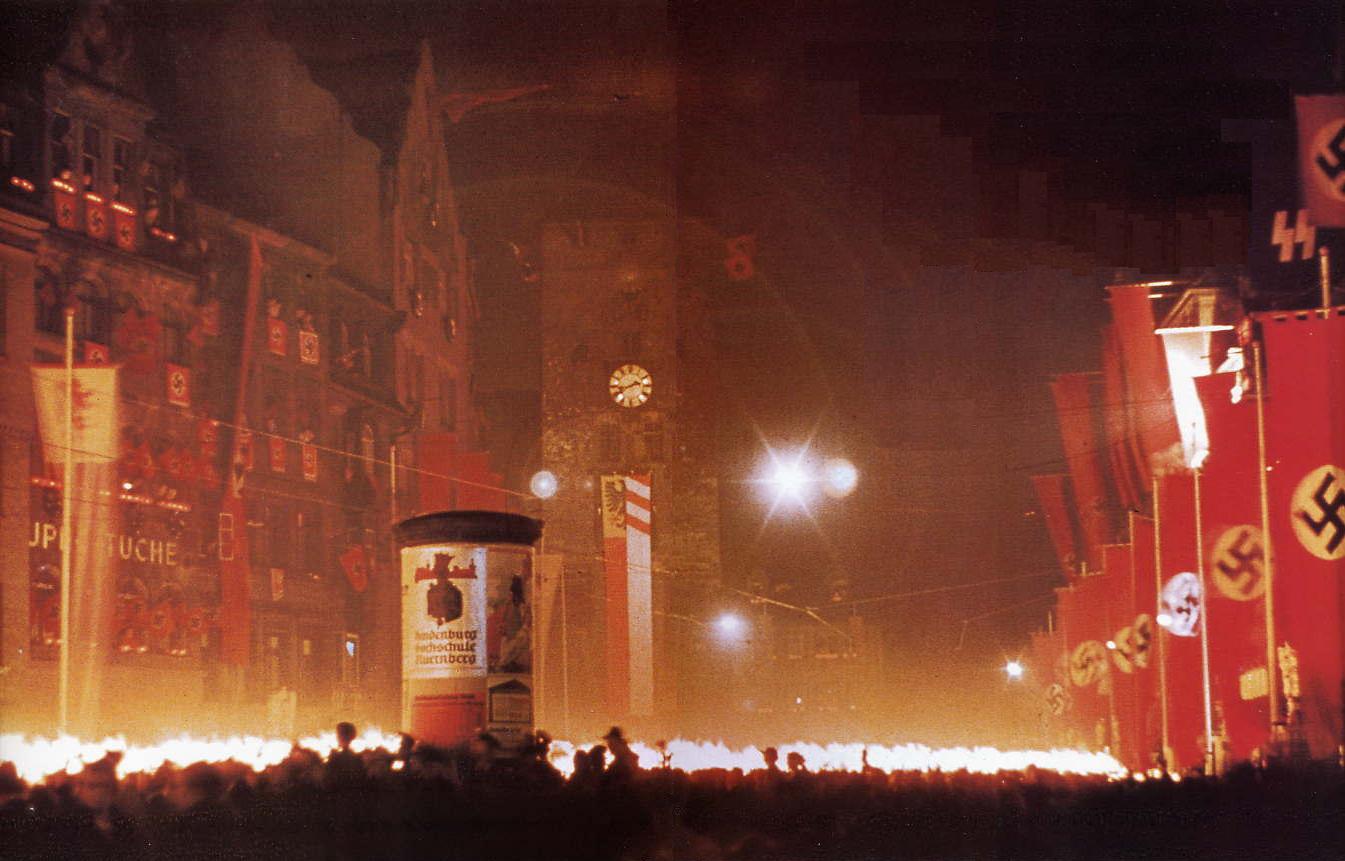
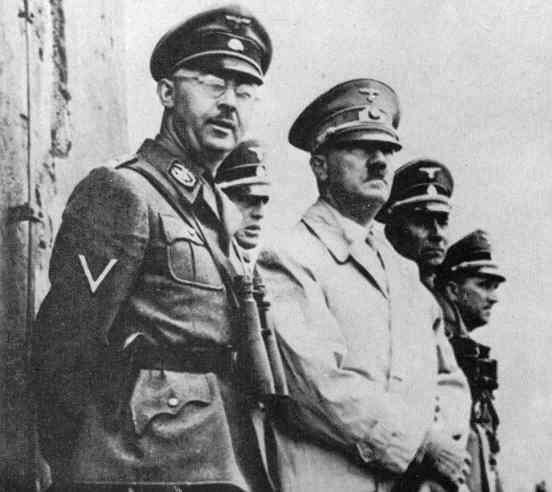
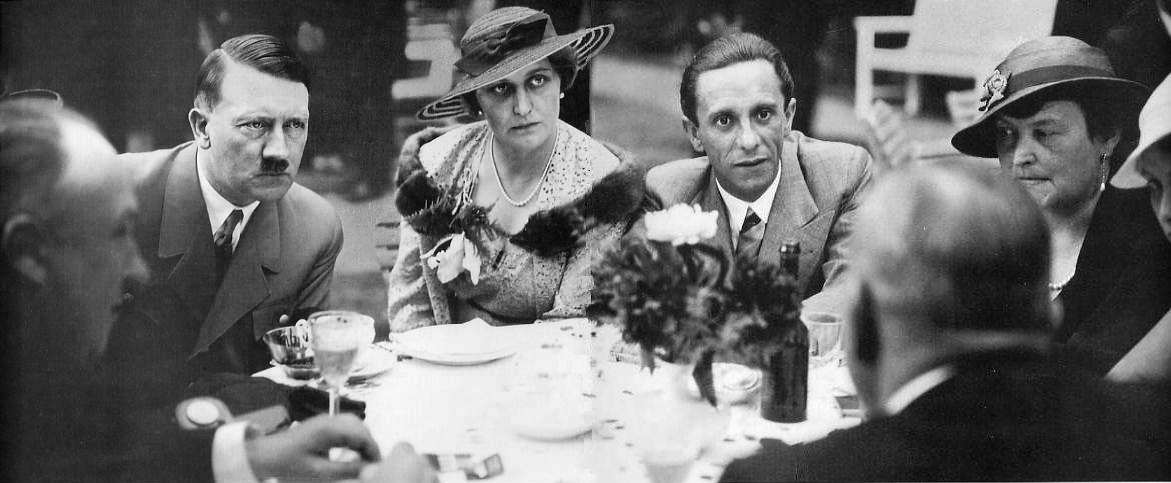
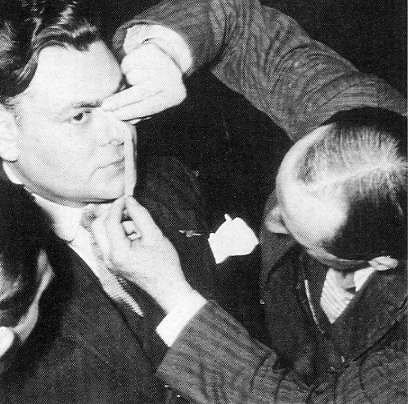
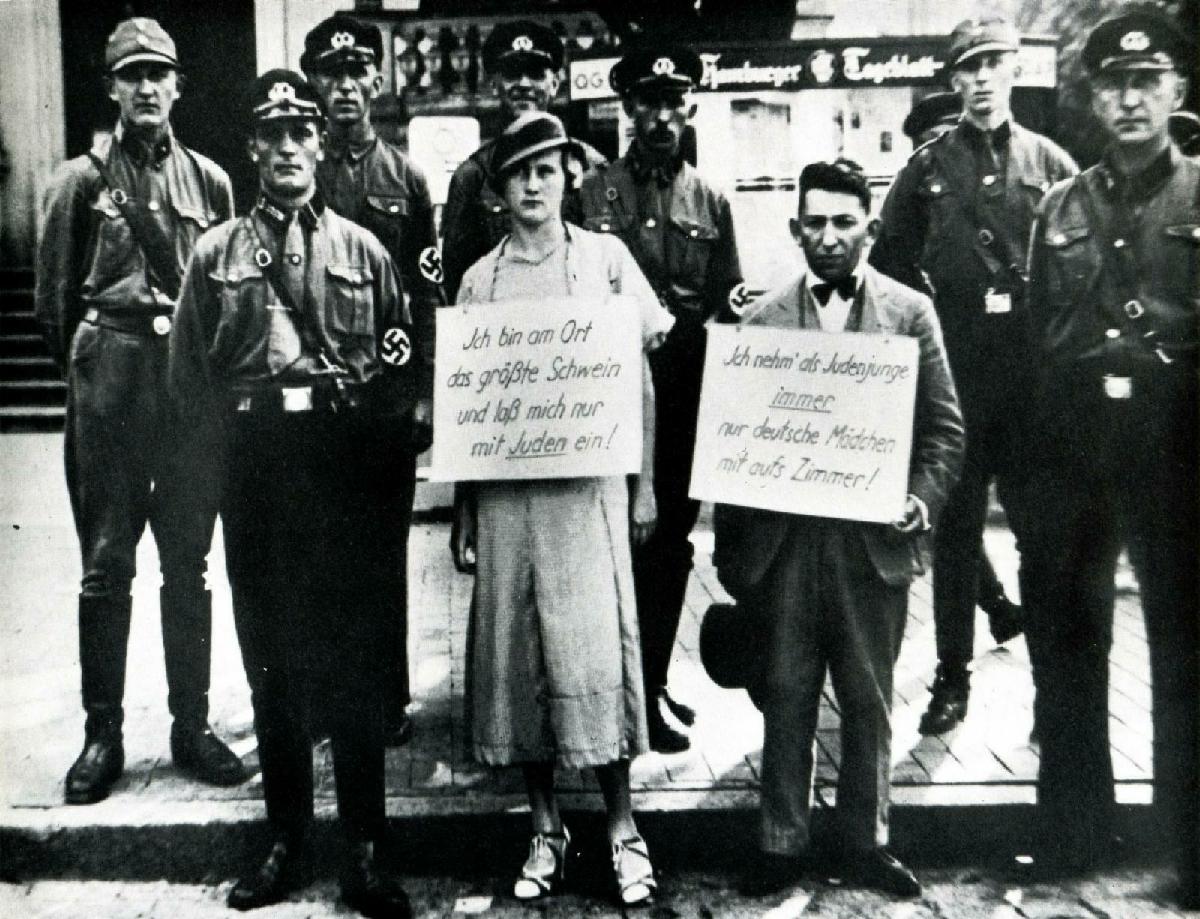











































































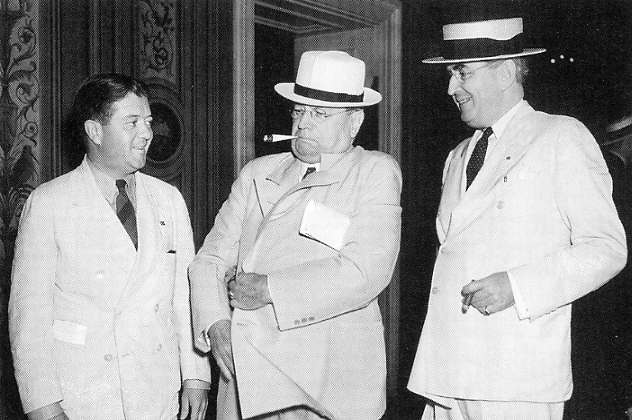
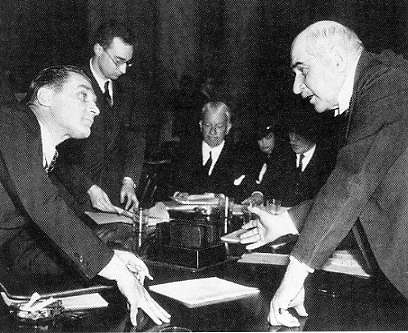
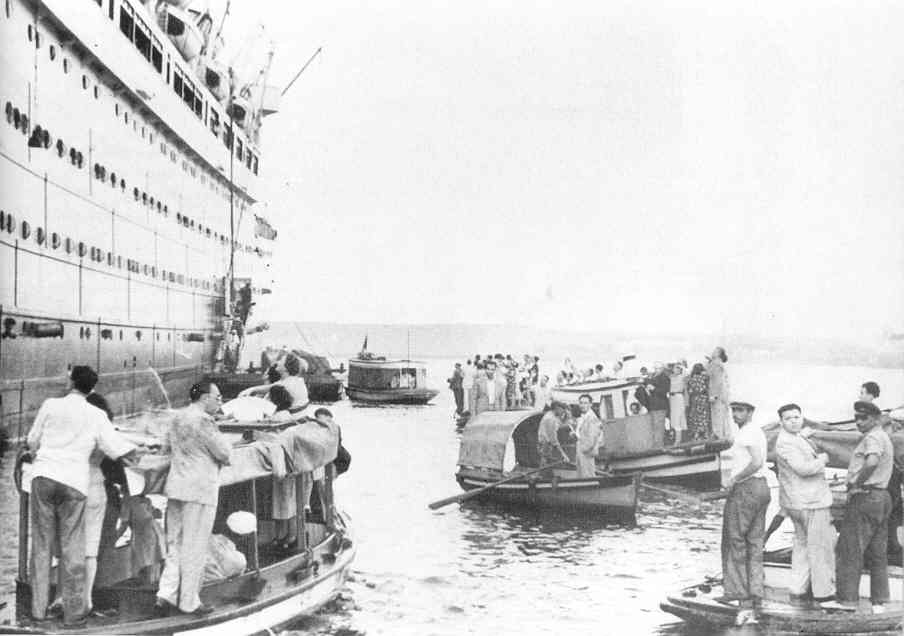


 Miles
H. Hodges
Miles
H. Hodges